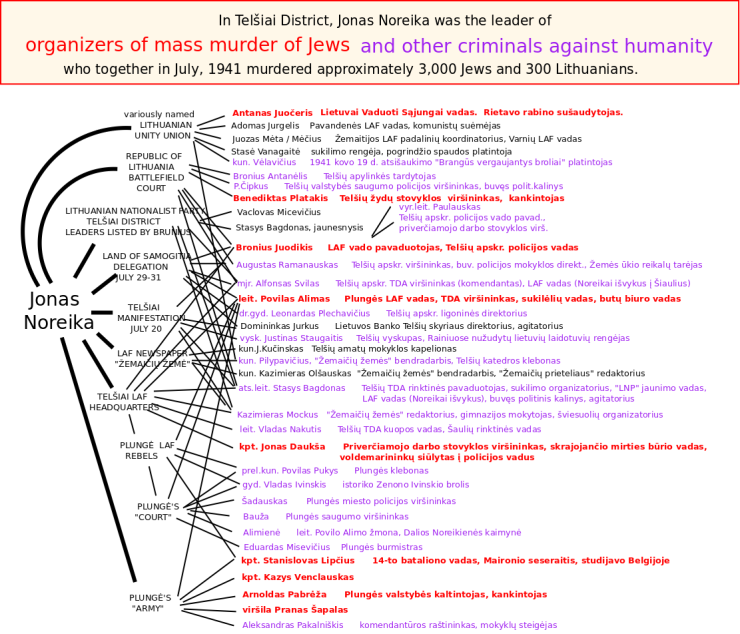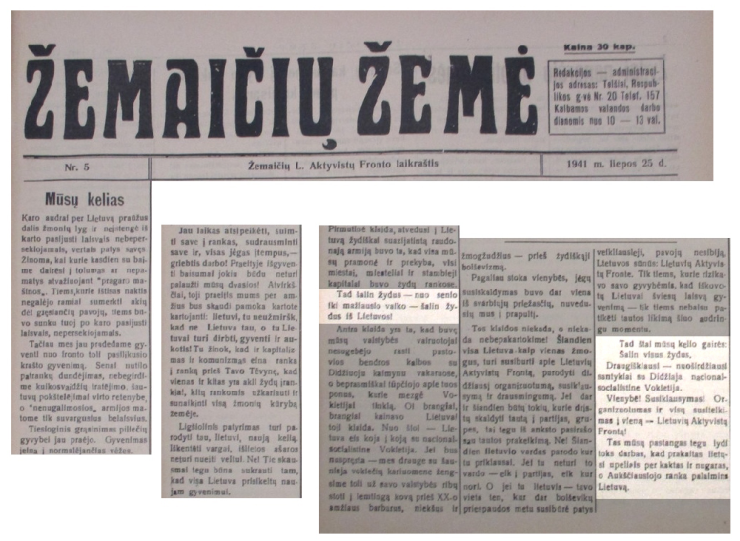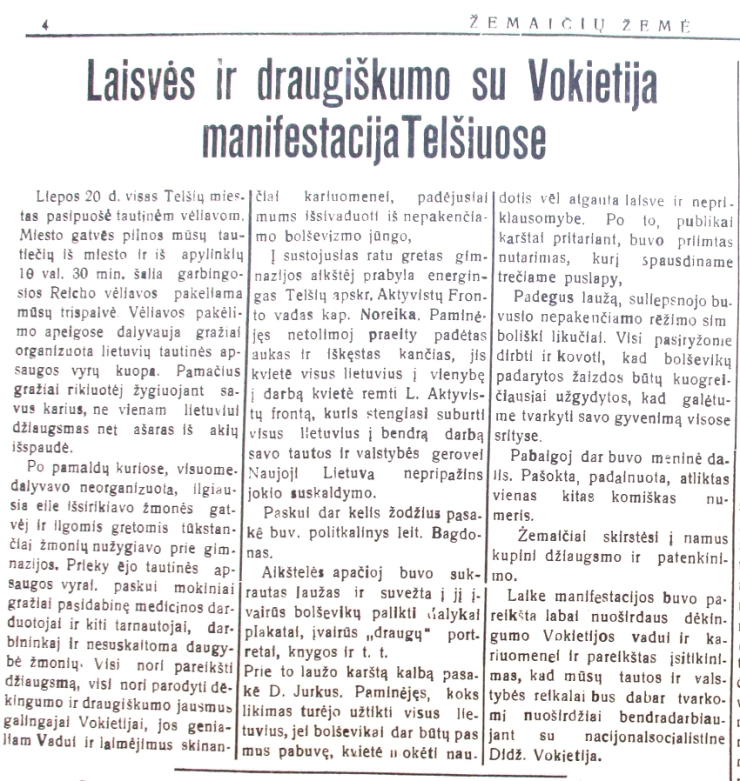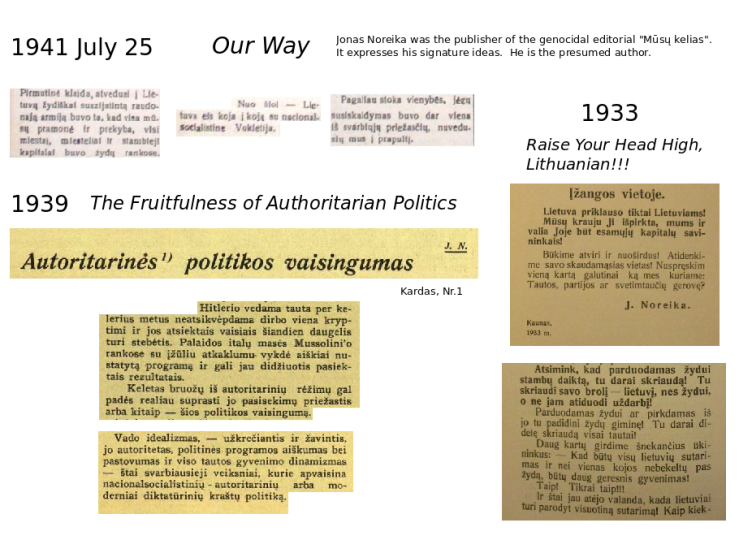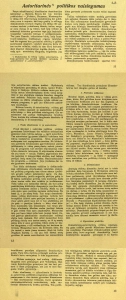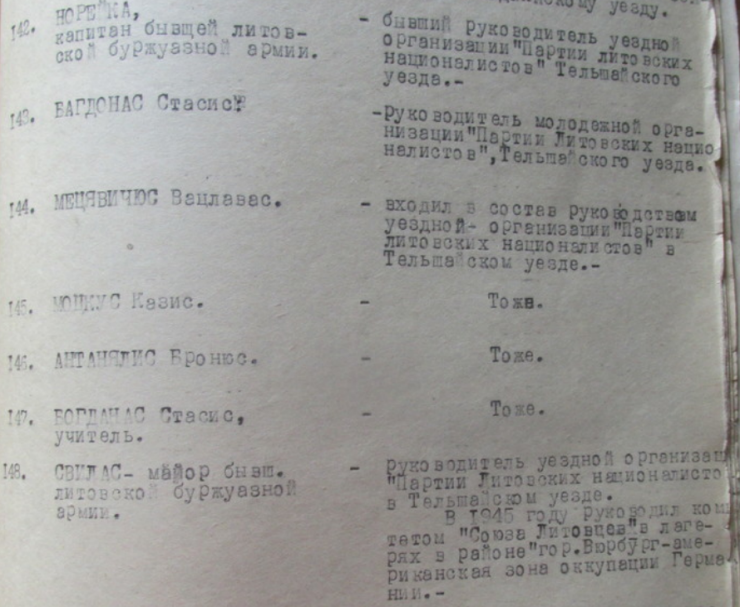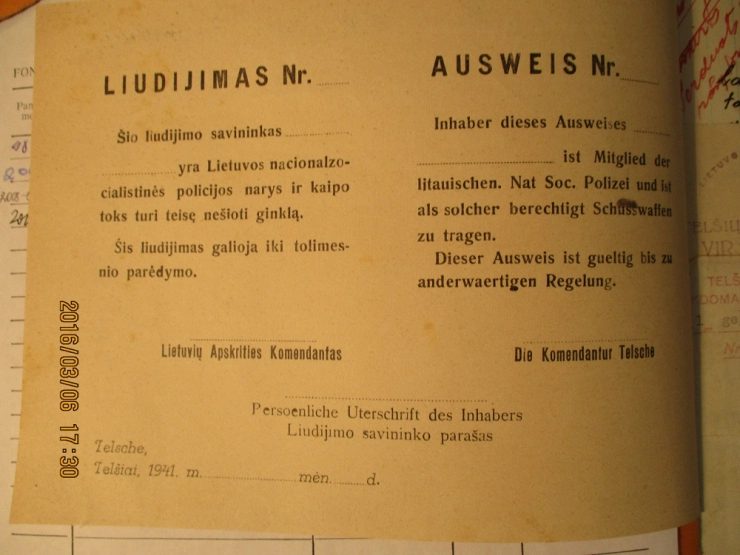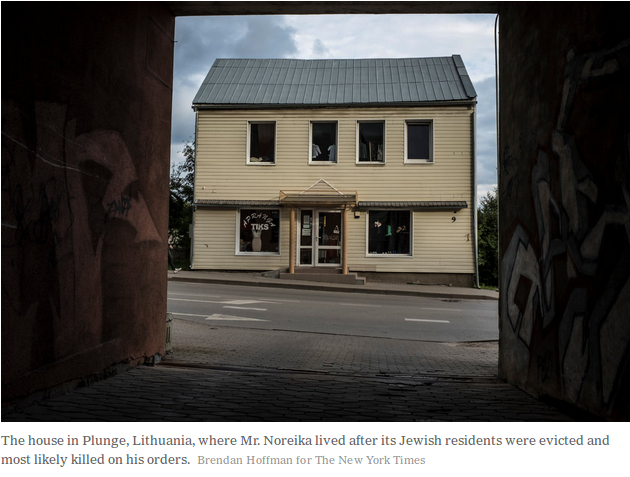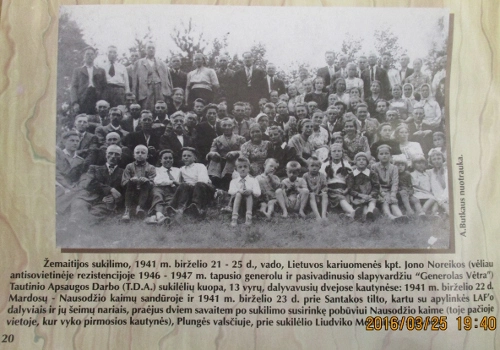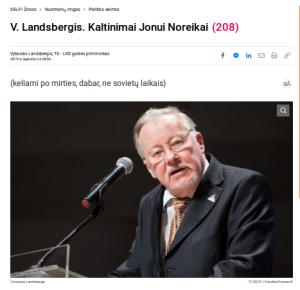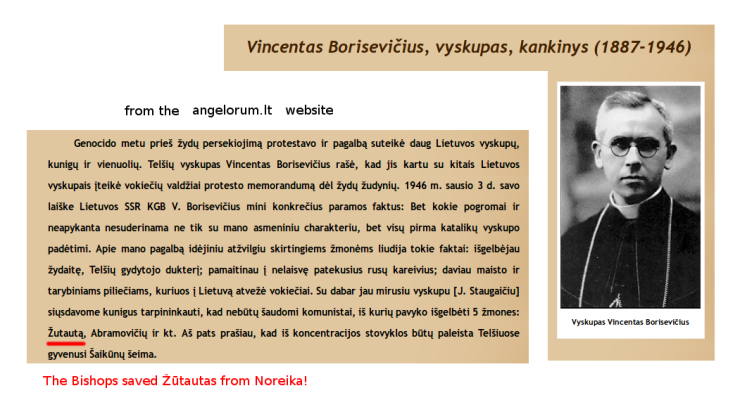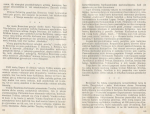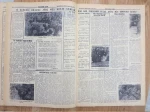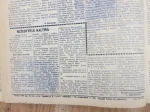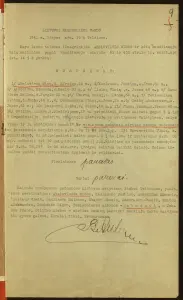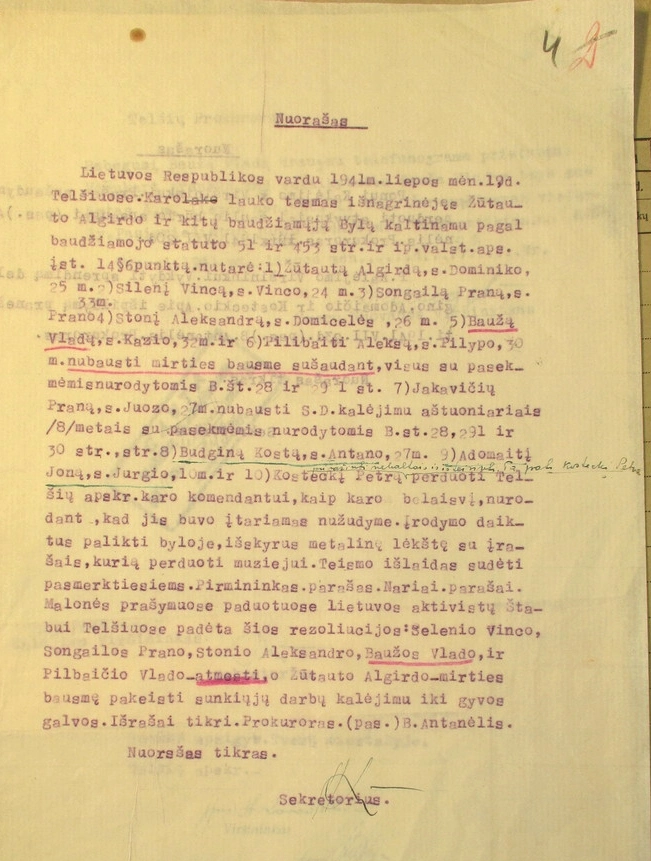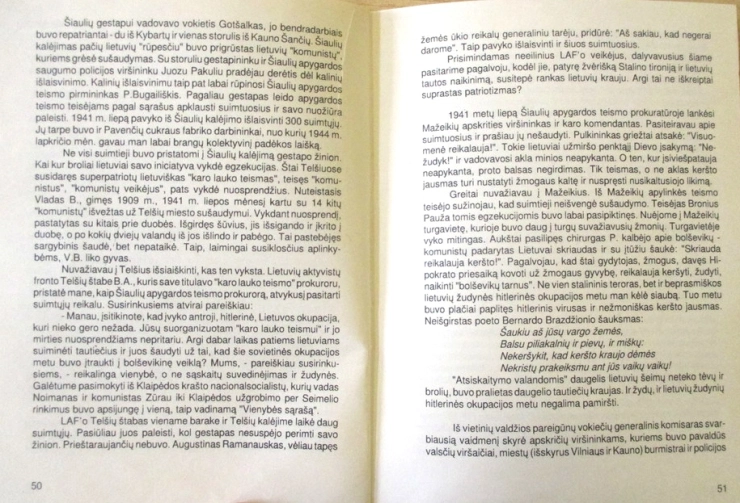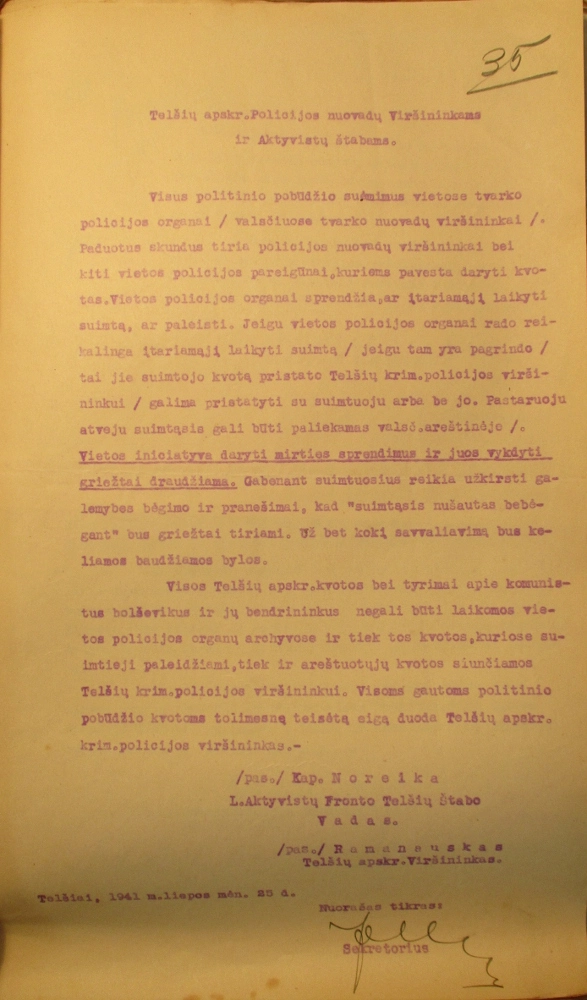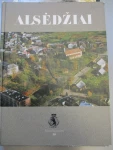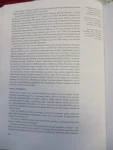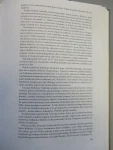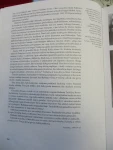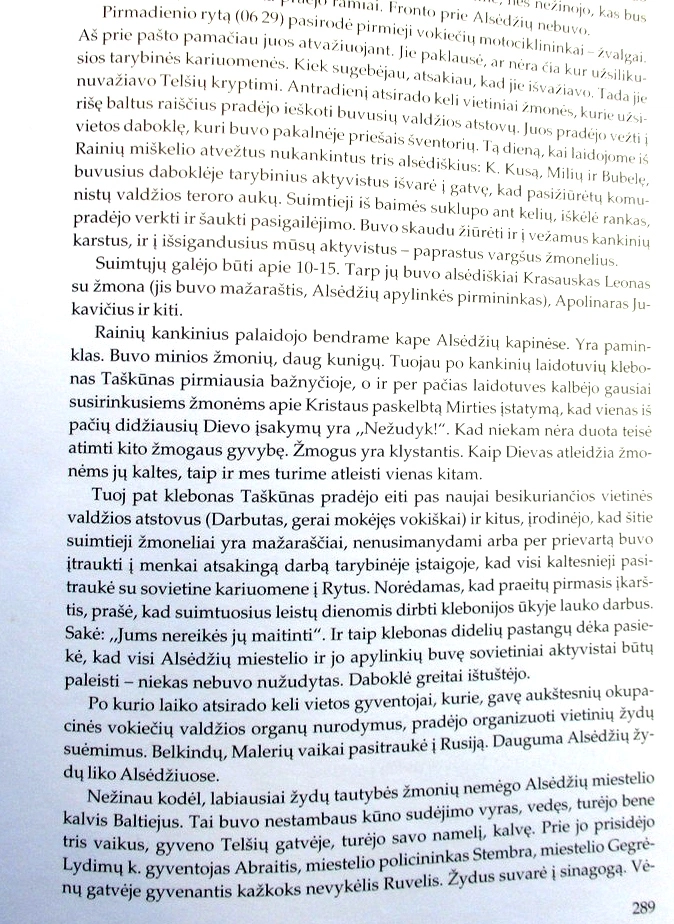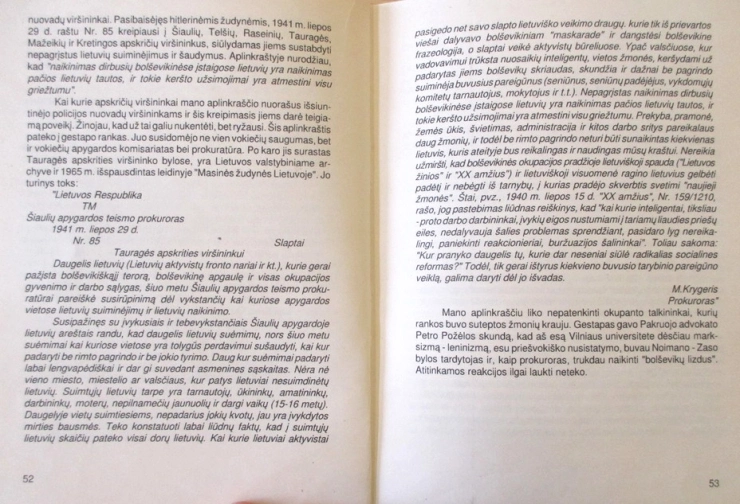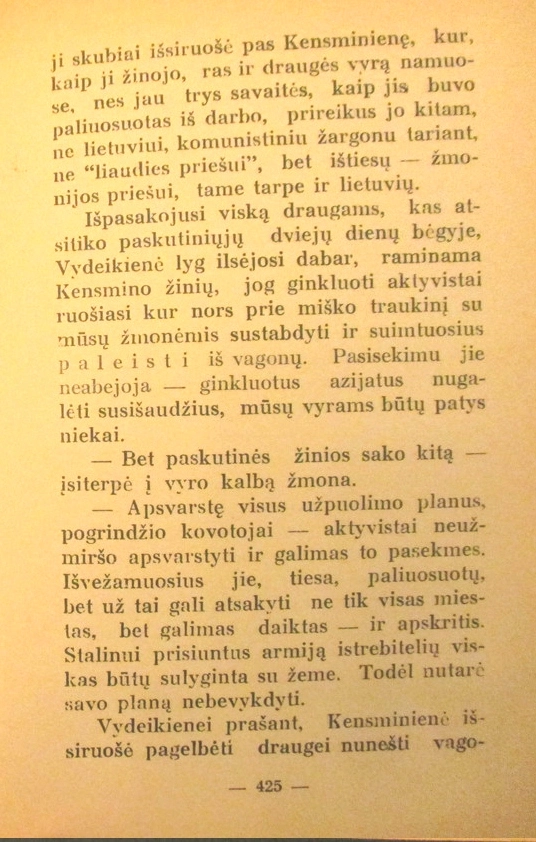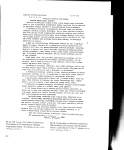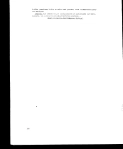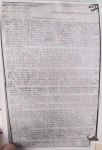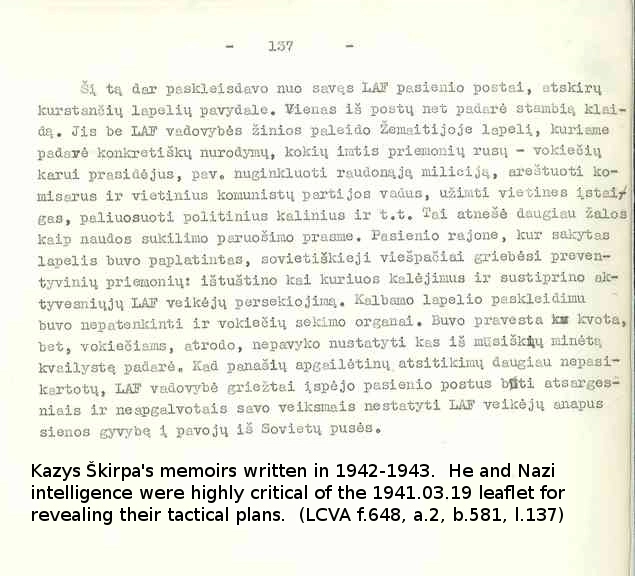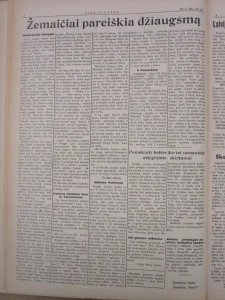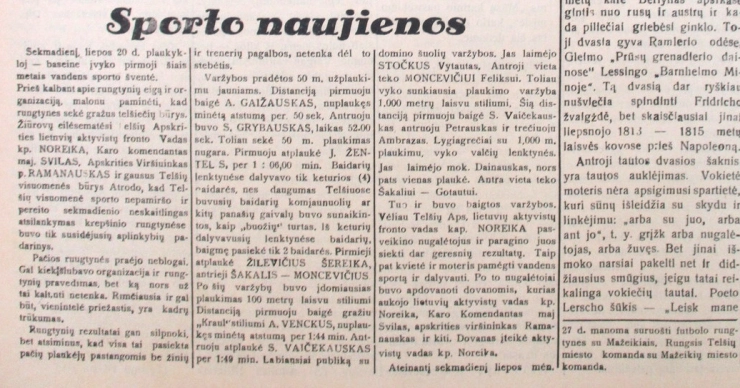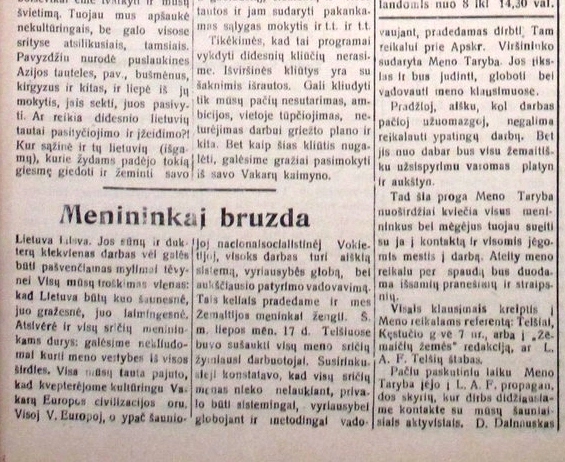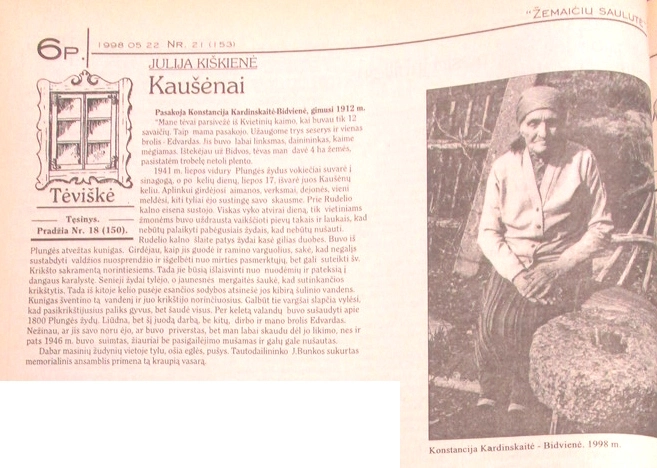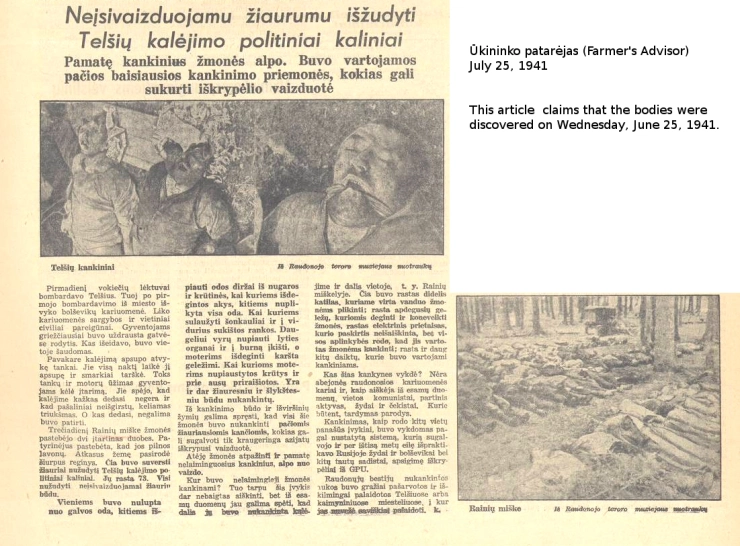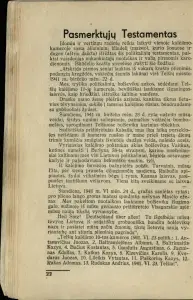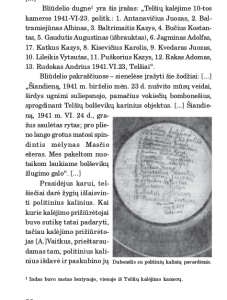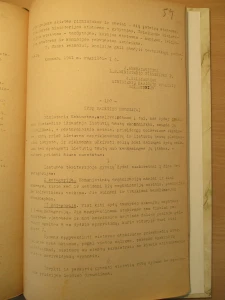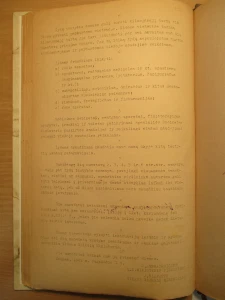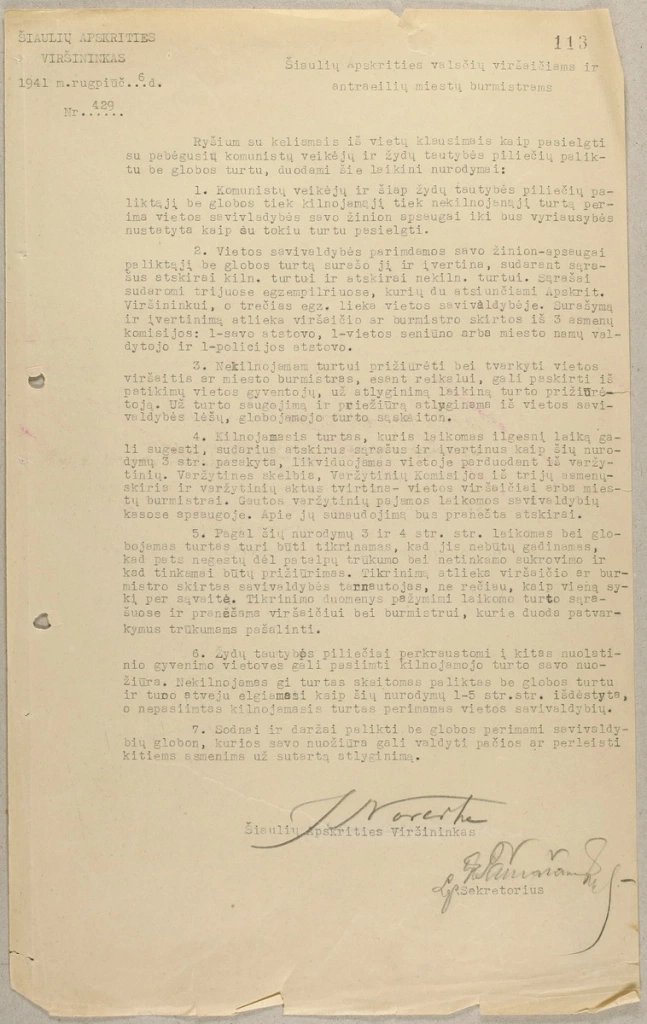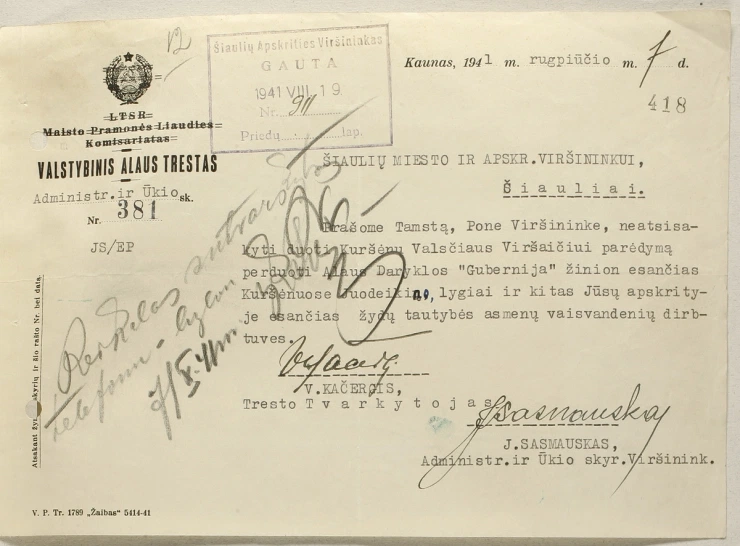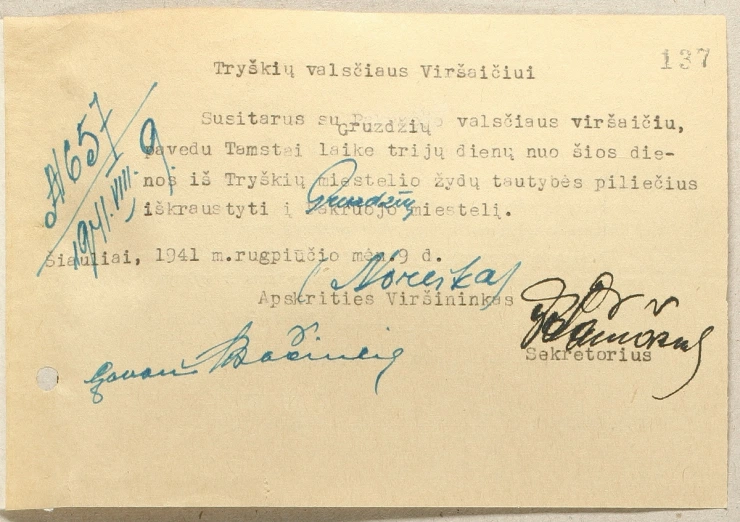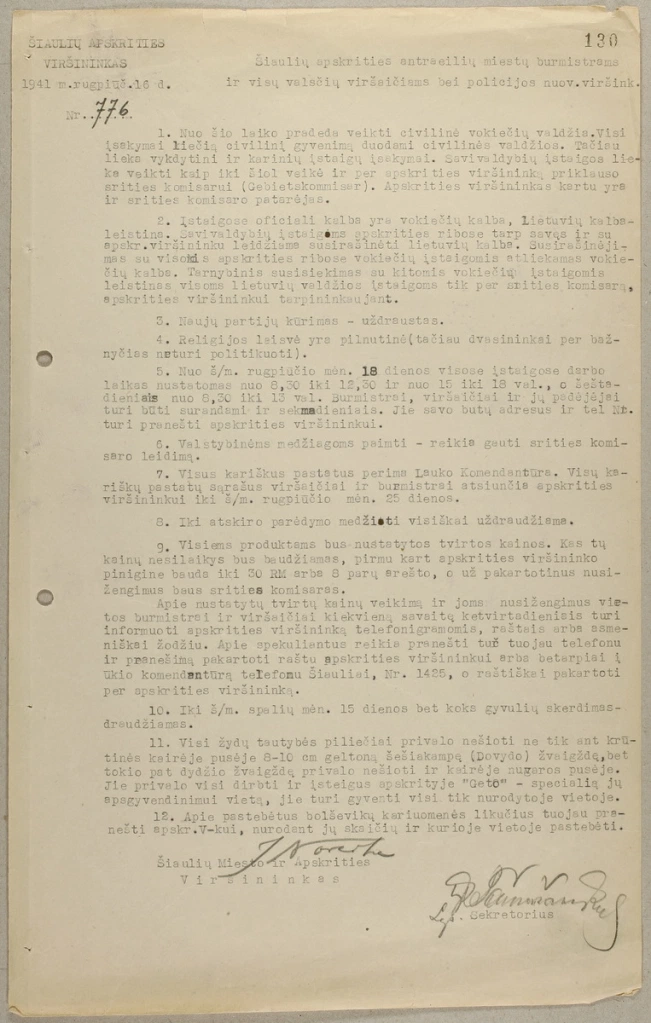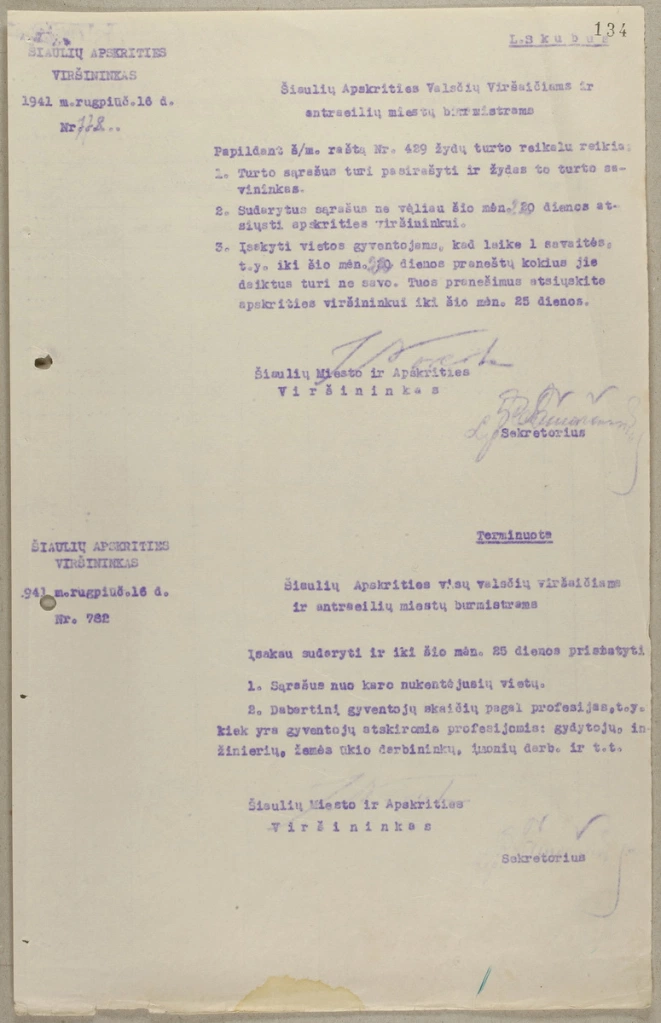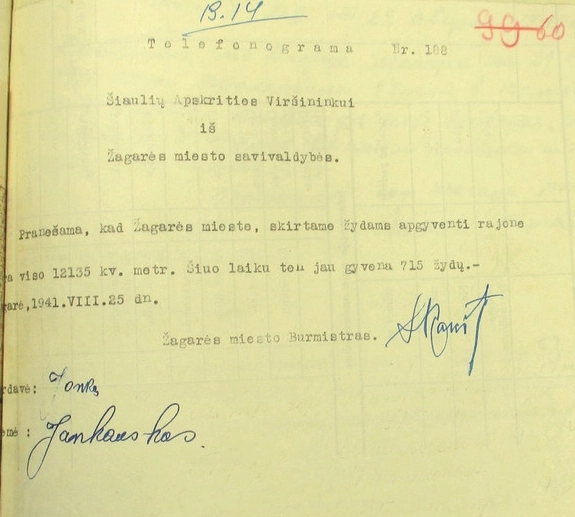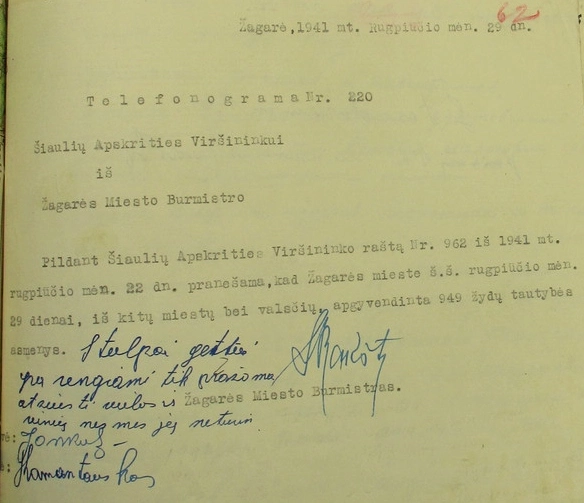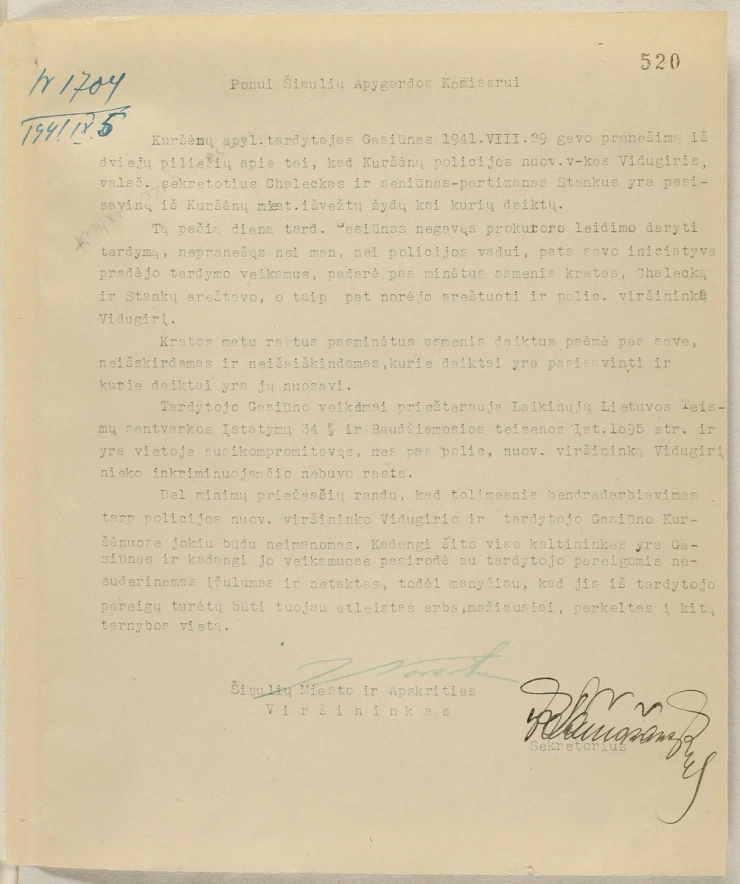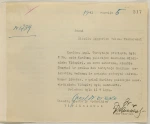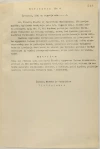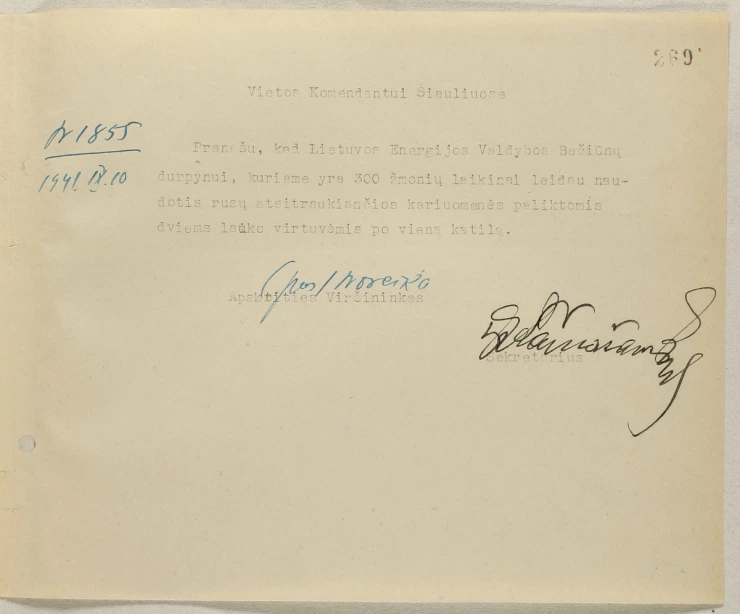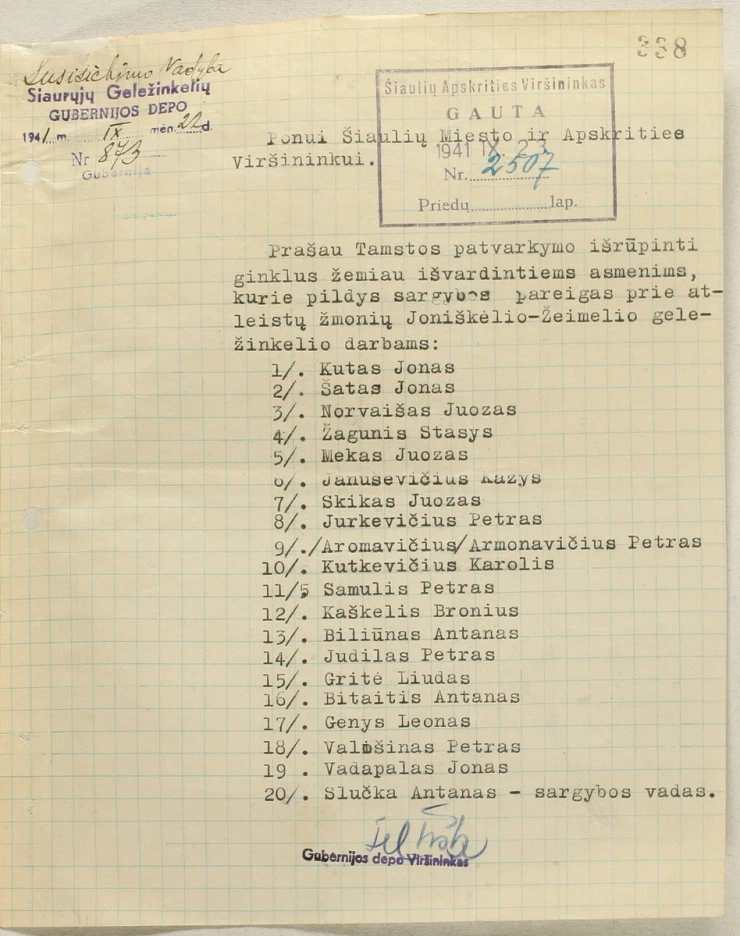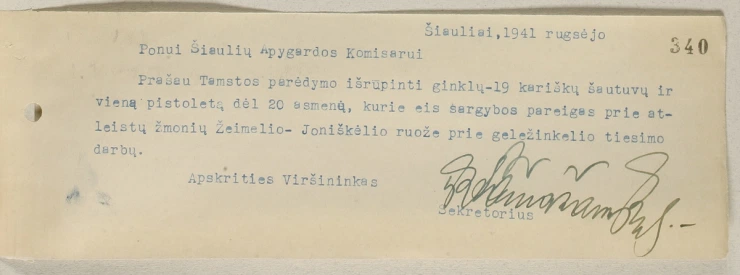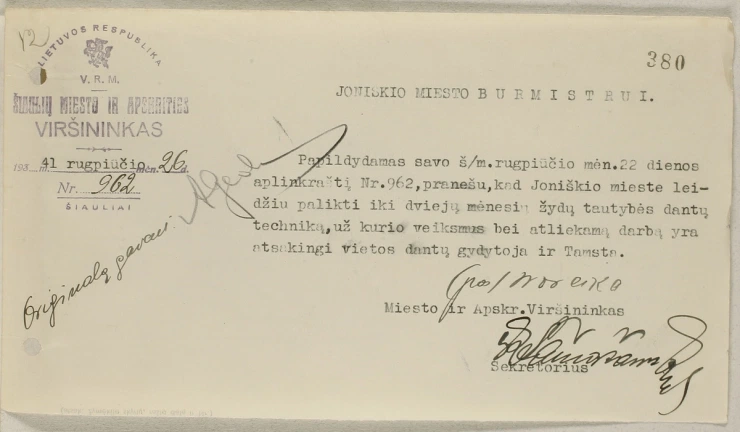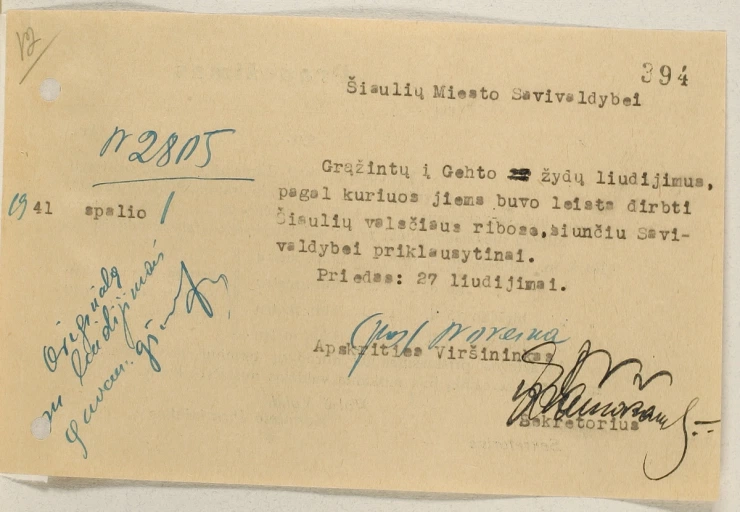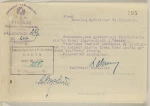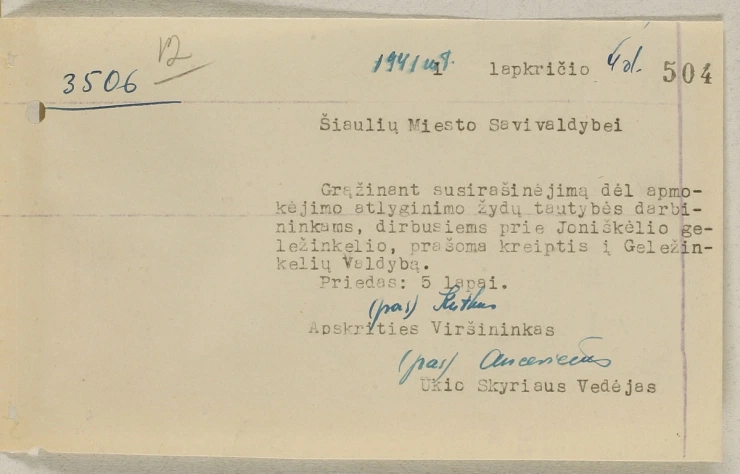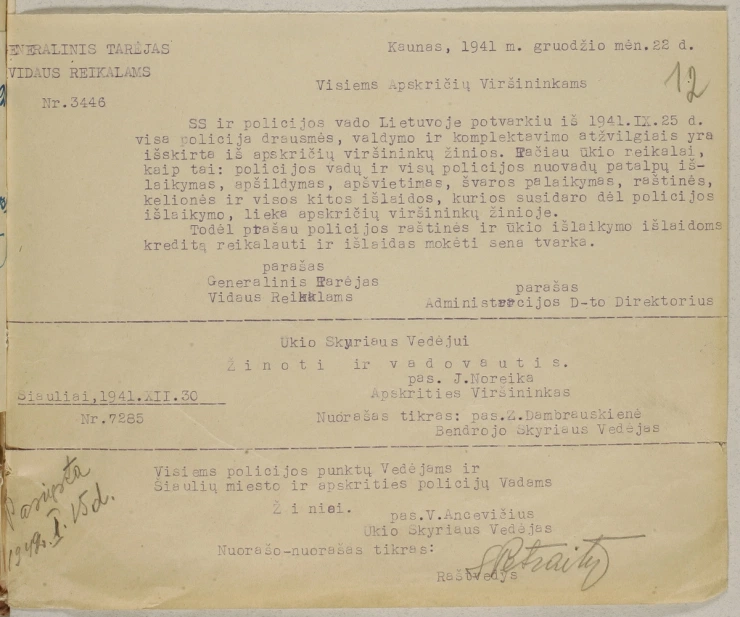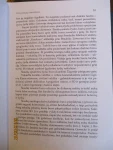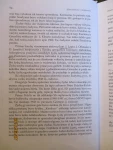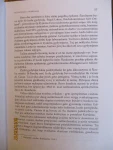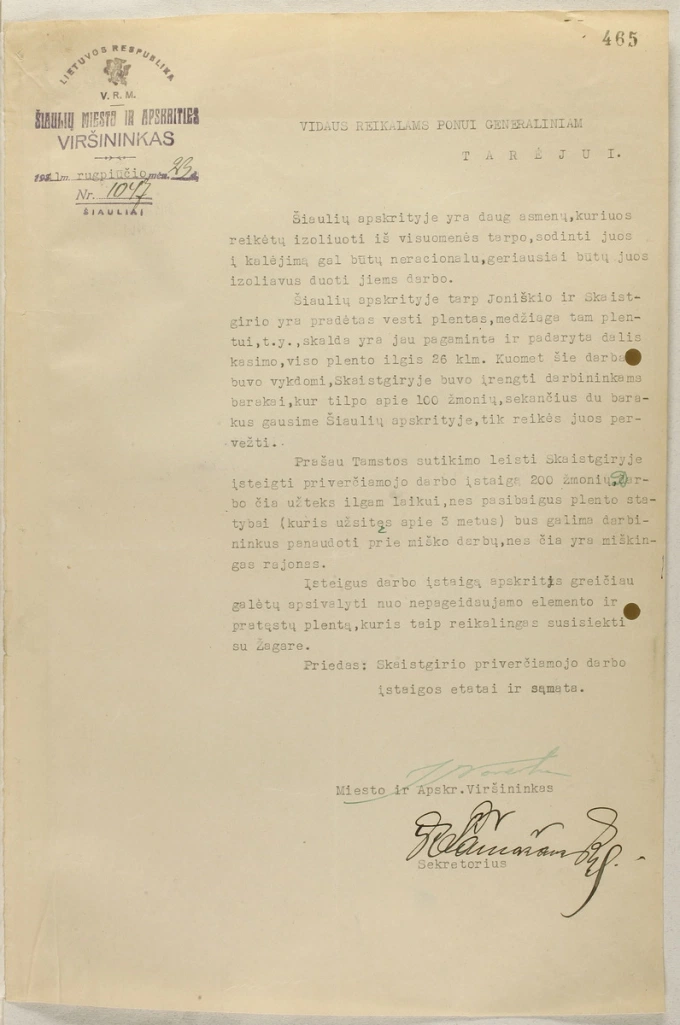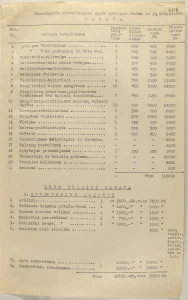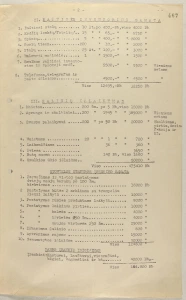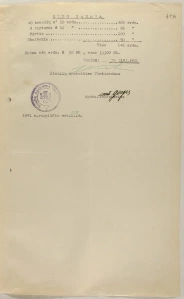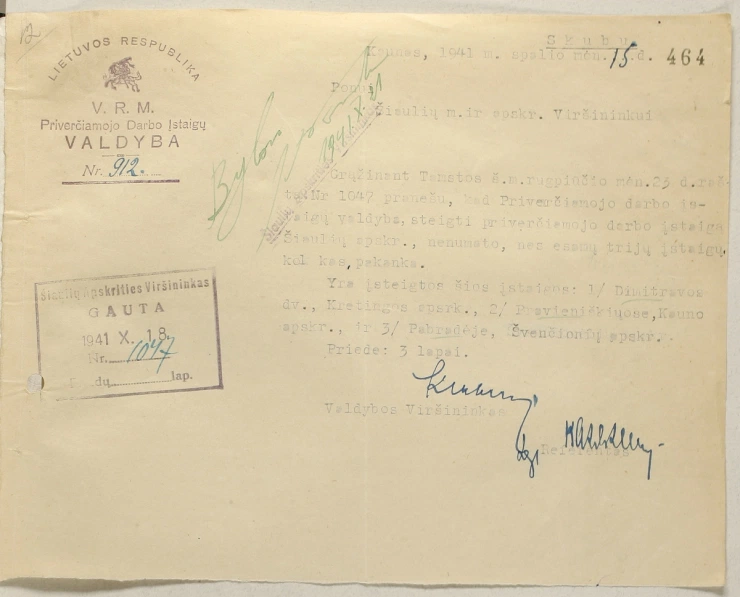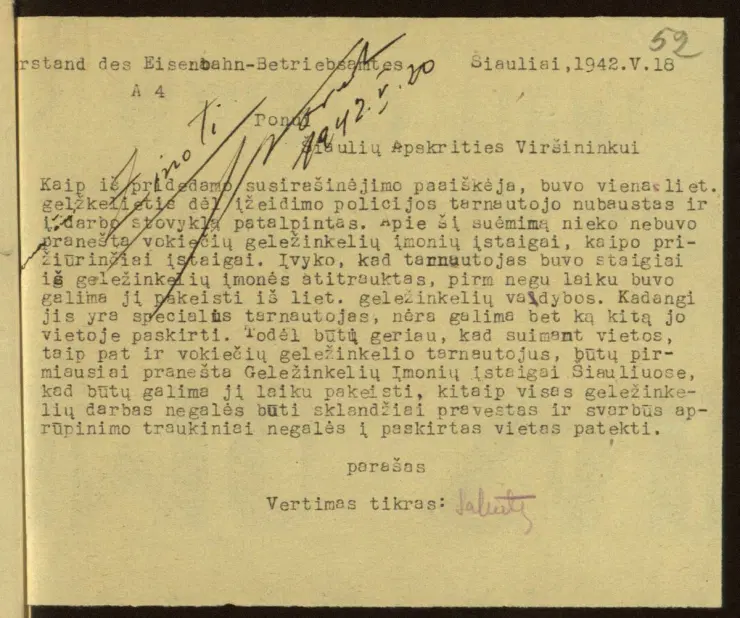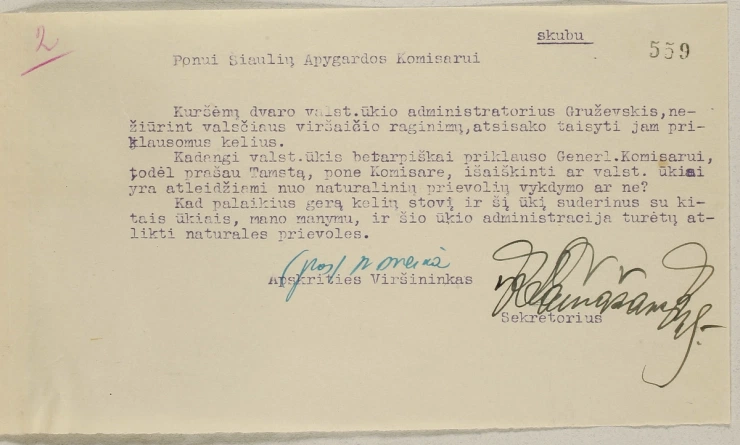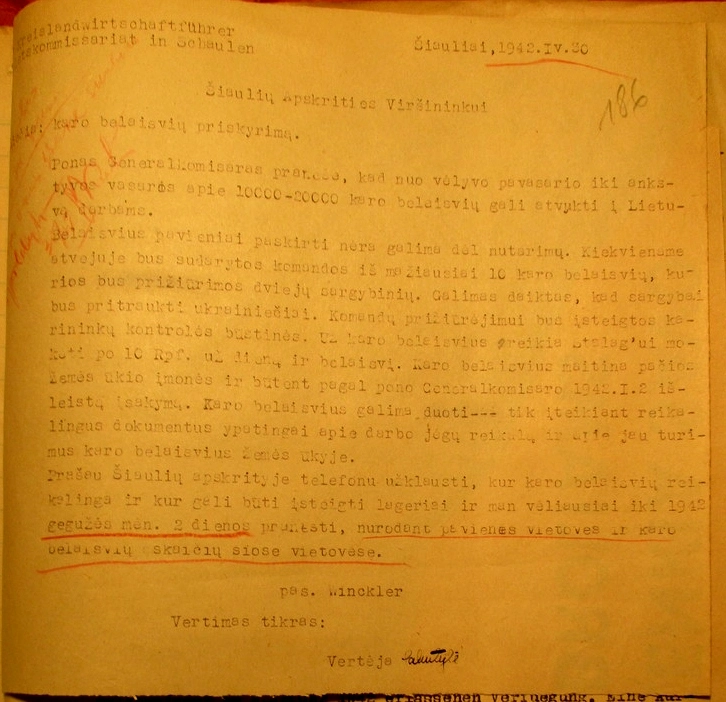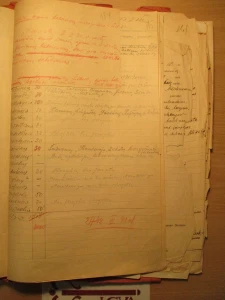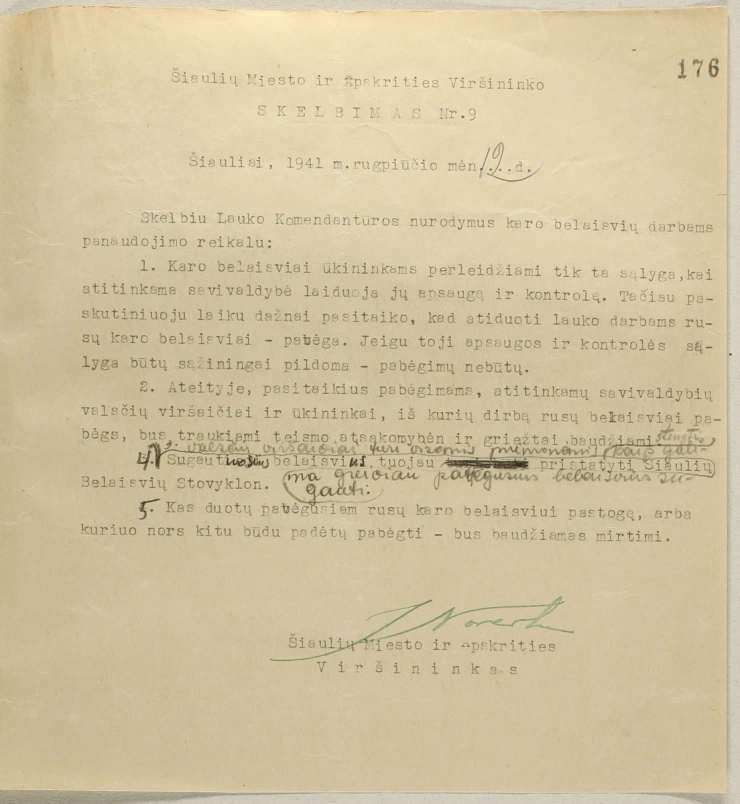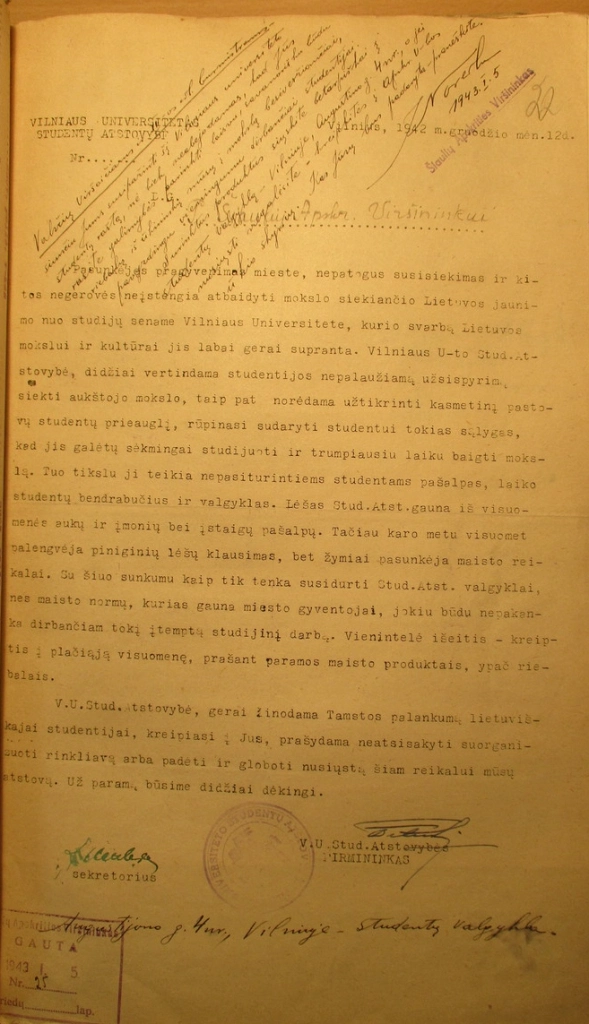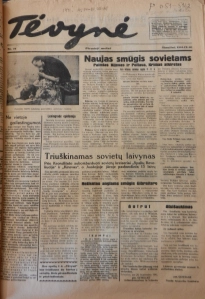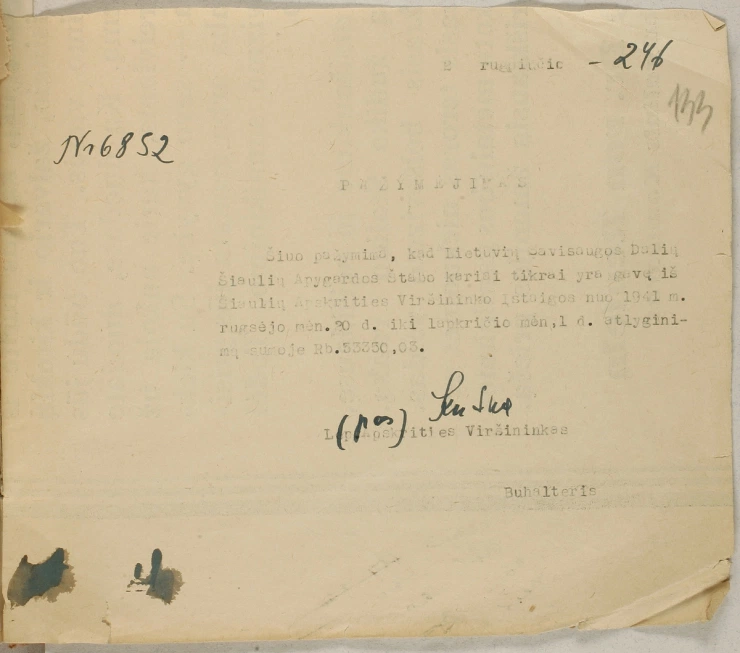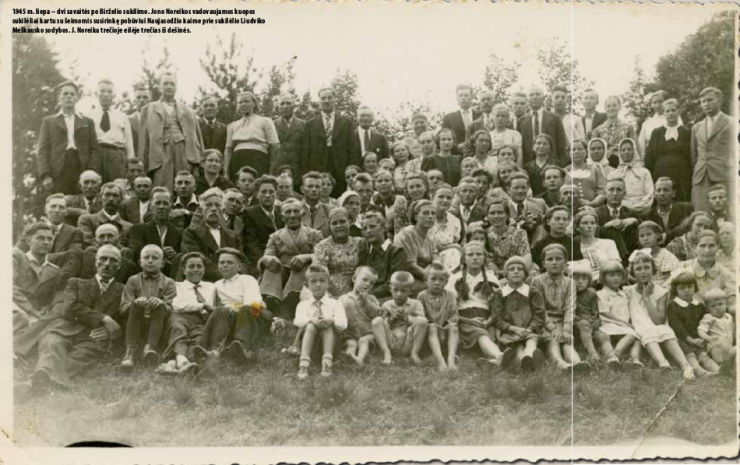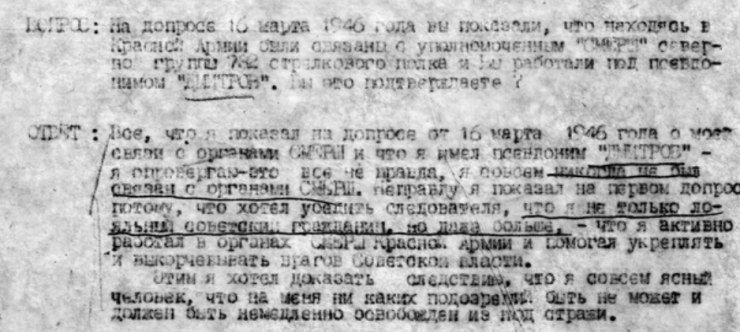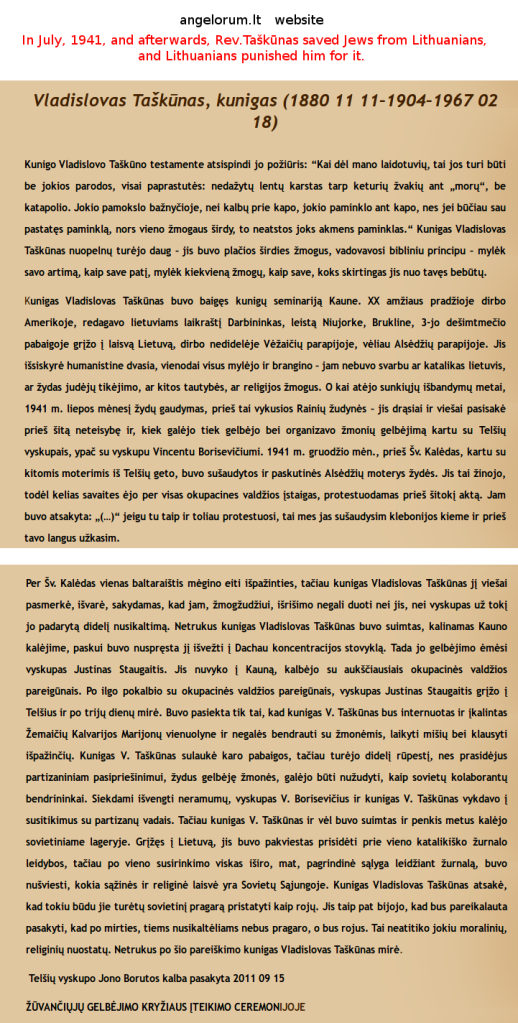Captain Jonas Noreika Museum and Archive make available online the documents that captured his crimes, his outlook and his world. Dr. Andrius Kulikauskas is the curator.
Grant Gochin’s relentless query to Lithuania’s Genocide Centre, in English translation and the Lithuanian original, now serves below as the online museum’s main exhibit: Noreika a Hero? A second exhibit showcases Orders Signed by Noreika. The documents which Gochin’s investigators assembled form the heart of the Captain Jonas Noreika Archive.
Noreika a Hero?
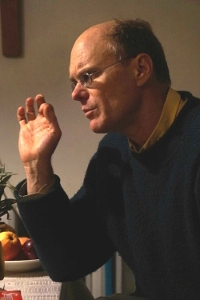
The Genocide and Resistance Research Centre of Lithuania is the state institution which officially responds to queries by public officials and private citizens whether or not to publicly honor Lithuanians for their actions during the Soviet and Nazi occupations. In 2015, various Litvak and Lithuanian intellectuals spoke out in the press and social media to object to the honoring of Captain Jonas Noreika. In particular, the children’s school in his hometown, Šukioniai, is named after him. In the capital Vilnius, a plaque dedicated to Noreika is prominently displayed at the entry to the Library of the Academy of Sciences, where he worked in 1946. Government officials referred the matter to the Genocide Centre, as it is widely called. In November, 2015, the Genocide Centre officially responded with a mixed message that Jonas Noreika could not be judged unequivocally, which is to say, he could not be understood as simply a hero or simply a villain.
Grant Gochin, a Lithuanian citizen, found this reply disingenuous and hurtful. In 2018, he asked me, Andrius Kulikauskas, to work for him to research Jonas Noreika’s crimes against humanity. When the two of us had met online in 2012, we had disagreed about Lithuanian responsibility for the Holocaust. This led me to delve into the question. My report, How Did Lithuanians Wrong Litvaks?, is a sobering overview of the Holocaust in Lithuania in 1941. Evaldas Balčiūnas joined us to read through thousands of pages of NKVD interrogations and other documents which I photographed or purchased at the archives in Vilnius. Evaldas was the blogger who in 2012 had asked, Why Is Jonas Noreika a National Hero?
We got in touch with Eugenijus Bunka, Bronislavas Pocius and Zita Paulauskaitė, residents of Plungė who had not kept quiet about Captain Jonas Noreika’s responsibility for the genocide of Plungė’s Jews. That’s how we found out about Silvia’s journey to Plungė and what she had learned from her aunt. We approached Silvia. Would she confirm what we had learned?
Silvia contributed the following letter. It now serves as the introduction to Grant’s expansive query, which is likewise simply an introduction to the thousands of documents that let us see the tragedy of the Holocaust and Captain Jonas Noreika’s responsibility.
Confirmation For Jonas Noreika’s Historical Research

I am Silvia Foti, Jonas Noreika’s granddaughter.
After almost two decades of personal research, I have arrived at the same conclusion as Grant Arthur Gochin concerning my grandfather Jonas Noreika’s actions during World War II. I found incontrovertible evidence by way of historical documents and witnesses who have told me that Jonas Noreika ordered the slaughter of Jewish Lithuanian citizens. As part of my research, I visited Telšiai, Plungė, Kaunas, Šauliai, Vilnius, and Klaipėda to speak with the locals and study archived documents. It is painful for me, but I am prepared to talk about my findings.
On July 17, 2013, I met with The Genocide and Resistance Research Centre of Lithuania Director, Birutė Teresė Burauskaitė. I told her that I thought it strange that Jonas Noreika was considered a hero in Lithuania when there were documents with his signature ordering the isolation of Jewish people in ghettos, as well as the expropriation of their belongings. Her response was, “It is psychologically difficult to comprehend what he was thinking and feeling when he signed those papers. All Jews were sent away. I don’t know what was going on in his mind. The result of course, were that Jews were killed.” The Center’s historian, Arūnas Bubnys later told me, “Within the KGB transcripts there are is no evidence that Jonas Noreika was associated with the killing of Jewish citizens.” Later, in 2016, the Center published a similar document, essentially exonerating John Noreika’s actions during World War II based on their findings in the KGB transcripts.
I have reviewed the KGB transcripts on my grandfather and have noticed that the KGB never interrogated J. Noreika on the genocide of Jews. It was not part of their focus.
I believe that when the Genocide Center resorts to interpreting historical documents, signed by my grandfather, that resulted in the genocide of thousands in Lithuania by intentionally misconstruing his psychological state as well-meaning is a prime example of how the national government denies its role in the Holocaust and twists its own history to obscure its responsibility.
Historical data and my own research shows that Jonas Noreika, as a leader of the Lithuanian Front Activists and chairman of the Šiauliai region, ordered the isolation of thousands of Jews, which he knew would result in their slaughter. Yet his actions were deliberately concealed by the government through the Genocide Center. This, unfortunately, is perhaps the nation’s largest cover-up of the 20th century.
Silvia Foti
2018-05-25, USA
Here is the PDF
which includes Grant Gochin’s original query, in Lithuanian, the
translation into English, and my accompanying letter. The translation
below includes links to documents as well as images not present in
the original. Also at my website is a similar page based on his original query in Lithuanian. Grant sent out his query on June 15, 2018. Here is the Genocide Centre’s response, in Lithuanian.
June 15, 2018

Grant Arthur Gochin
10900 Winnetka ave,
Chatsworth, CA 91311
United States of America
The Genocide and Resistance Research Centre of Lithuania
Didžioji g. 17/1, Vilnius
Query Regarding Jonas Noreika’s Criminal Gang
The Genocide and Resistance Research Centre of Lithuania, General Director Teresė Birutė Burauskaitė,
I ask for a reasoned answer to this question:
Is it true that Jonas Noreika’s activity “may not be judged unequivocally”?
In your certificate of November, 2015 you assert that
- the investigations which you conducted let you postulate that J.Noreika’s activity during the time of the German occupation “may not be judged unequivocally”;
- your historians have “comprehensively investigated” Jonas Noreika’s activity during the time of the German and Soviet occupations.
I want to ask you: Why don’t we agree regarding Jonas Noreika’s crimes against humanity?
I write with the purpose to demand that the Genocide and Resistance Research Centre of Lithuania unequivocally condemn Jonas Noreika and change its published conclusions.
I, a Lithuanian citizen of good will, wrote to you earlier in order that you realize that your certificate’s vague conclusions in the name of the Republic of Lithuania hurt the victims of Jonas Noreika and other criminal Lithuanian rebels. On April 10, 2017, in replying, you suggested that I organize an independent historical investigation, which I did.
Jonas Noreika’s activity was investigated by VGTU Department of Philosophy and Cultural Studies Lecturer Andrius Kulikauskas and Evaldas Balčiūnas. The scope of the investigation was vast. More than 850 work hours were expended. 510 euros was spent on files from the Lithuanian archives. More than 20,000 pages were photographed and reviewed from documents, which should be made public, and which bring to light Jonas Noreika’s crimes and their circumstances. Here are the findings of the historians:
I) Jonas Noreika led a criminal gang, LAF Telšiai, which, in the names of the Republic of Lithuania, the Lithuanian nation and “The Land of Žemaitija”, murdered in one month more than 3,000 Jews and 300 Lithuanians, arrested them, demeaned them, robbed, exploited, tortured and condemned them. The crimes of LAF Telšiai, in terms of their scope, cruelty, dedication and mendacity, exceed the Soviet Union’s, Nazi Germany’s and czarist Russia’s crimes in Telšiai district. In a single month, LAF Telšiai managed to commit more crimes in Telšiai district than did any occupying force over the course of decades.
II) Jonas Noreika served the Lithuanian Provisional Government and the Nazi occupiers in Šiauliai district because he, as an individual, was personally most suitable in organizing crimes against humanity.
Jonas Noreika horribly, wholeheartedly, willfully, passionately, comprehensively, unequivocally committed crimes against humanity.
Outline of the Query
Are your centre’s investigations scientific and your conclusions correct?
-
Let us name the Lithuanians who committed various crimes against humanity.
-
It suffices to read through a single newspaper, “Žemaičių žemė” Nr.5.
-
Jonas Noreika’s thinking is inappropriate for Lithuania’s youth.
-
Jonas Noreika’s delegation of murderers betrayed the state of Lithuania.
-
Jonas Noreika was an Iron Wolf (LNP) in sheep’s clothing (LAF).
-
How can Alimas be guilty, but not Noreika?
-
Who is more responsible than Jonas Noreika for the genocide of Jews in Telšiai area?
-
The Germans handed over the Telšiai district to the Lithuanian National Zocialist police.
-
Listen to the residents of Plungė and to Jonas Noreika’s granddaughter Silvia Foti.
-
Aleksandras Pakalniškis conscientiously revealed the crimes of Noreika and his army.
-
Noreika was the highest authority in Telšiai district.
-
Jonas Noreika was morally obliged to save Lithuanians and Jews.
-
Jonas Noreika did not care to rescue deported Lithuanians.
-
Jonas Noreika’s underground press fostered hatred.
-
Jonas Noreika united society in criminal activity.
-
Jonas Noreika spiritually desecrated Jewish victims.
-
Jonas Noreika spiritually desecrated Lithuanian victims.
-
Jonas Noreika was best suited for the crimes envisaged in the Šiauliai area.
-
Jonas Noreika dutifully “isolated” the Jews of Šiauliai district.
-
Jonas Noreika perpetrated Nazi crimes more vigorously than his superior.
-
Jonas Noreika revealed himself in Šiauliai as a slave lord.
-
The 14th battalion ought to be called Noreika’s army.
-
Other criminals against humanity were likewise imprisoned in Stuthoff.
-
The creators of Noreika’s legends injure Lithuania.
Unequivocal conclusions. Jonas Noreika was an enemy of Lithuania and humanity.
-
Your investigations of responsibility are unscientific.
-
Your investigations of responsibility are incomplete.
-
Your investigations of responsibility are biased.
-
You are shirking responsibility.
-
Let’s not apologize nor disassociate, but rather acknowledge and regret.
-
Conscious people are responsible for everybody.
-
Jonas Noreika consciously depraved all of Lithuanian society.
-
Jonas Noreika is unequivocally reprehensible.
Are your centre’s investigations scientific and your conclusions correct?
How would you explain the completely differing conclusions of your researchers and my researchers?
My researchers acquainted themselves with your centre’s assertions about Jonas Noreika:
-
(LGGRTC, 2015) Your certificate about Jonas Noreika in 2015;
-
(Rukšėnas, 2016) your senior historian Alfredas Ruškėnas’s article, “Jono Noreikos-Generolo Vėtros biografijos kontroversijos”, which was published in your academic journal “Genocidas ir rezistencija”, 2016 m., Nr.1, p.39-64;
-
(Ašmenskas, 1997) your book, “Generolas Vėtra”, published in 1997, authored by Viktoras Ašmenskas.
They also acquainted themselves with your publications about the 1941 uprising, the Lithuanian battalions and Pranas Germantas-Meškauskas:
-
(Rukšėnas, 2010) Rukšėnas, Alfredas. “1941 m. birželio sukilimas Kretingos, Mažeikių ir Telšių apskrityse.” Genocidas ir rezistencija. 2010. 1 (27). p.31-57.
-
(Bubnys et al., 2011) Bubnys, Arūnas, Jegelevičius, Sigitas, Knezys, Stasys, Rukšėnas, Alfredas. Lietuvių tautos sukilimas 1941 m. birželio 22-28 d., LGGRTC, 2011.
-
(Bubnys, 2018) Bubnys, Arūnas, Lietuvių policijos batalionai 1941-1945 m., LGGRTC, 2017.
-
(Buchaveckas, 2013) Buchaveckas, Stanislovas, “Pranas Meškauskas-Germantas – lietuvių antinacinio pasipriešinimo Konradas Valenrodas.” Genocidas ir rezistencija. 2013. 2 (34). p.96-99.
We are trying to come to an understanding with you. We were not able to find within your research any explanation of the basis by which you investigate Lithuanian responsibility for crimes against humanity. Therefore we will share with you our experience, how we ourselves investigate Lithuanian responsibility.
Let us name the Lithuanians who committed various crimes against humanity.
The Republic of Lithuania is a nation state. Its constitution obliges concern for how the Lithuanian nation, especially those who express its will, are accountable for its and their behavior with respect to all people, but especially with regard to Lithuania’s minorities, with regard to innocent and vulnerable children, mothers and the elderly.
We focus on the question which concerns us: How responsible are Lithuanians for the crimes against humanity perpetrated in Nazi-occupied Lithuania? Such an investigation necessarily requires that we refrain from desires to justify Lithuanians.
It should first be noted that this is not a criminal investigation, but rather a moral investigation: What should we learn from history? It is understood that in time, ever new documents will arise, new facts will come to light, understanding will change, and new judgments will have to be made. However, the state must judge based on what is currently known, which person may be held exemplary, and which not?
We further ask, who desired to murder absolutely all Lithuanian Jews, including children, mothers and seniors? We note that, according to historian Christopher Browning, “The Origins of the Final Solution”, only in September, 1941, did Adolf Hitler resolve to murder all of Europe’s Jews. Prior to that there were other plans, such as deporting them to some corner of Poland, or to Madagascar or Siberia. This is to say that local actors influenced the genocide of Jews. And in Lithuania the genocide occurred amazingly early. Lithuanians on July 12-13, 1941 independently murdered all of the Jews of Plungė, 1,800 people. In all of Nazi-occupied Europe it was perhaps the first time that all Jews were murdered on such a scale, including children and mothers and the elderly. It is strange what an insignificant role the Germans played in such a historic event.
And who among the Lithuanians were most guilty? Most guilty are not the executors, but the conceivers. Not those who participated for the sake of rewards or other secondary purposes, but those idealists who dedicated themselves to the idea of genocide and resolved to sacrifice all they had to ensure the murder of children, mothers and the elderly. Especially guilty in Lithuania were Jonas Pyragius, Ričardas Šveiceris, Vytautas Reivytis, Pranas Germantas-Meškauskas and Jonas Noreika. Their words and deeds testify to that. Jonas Pyragius led the Voldemarist putsch on July 23-24, 1941, whose purpose was to deploy Lithuanian forces in the genocide of Lithuanian Jews. German Lithuanian Ričardas Šveiceris, as Einsatzgruppe A commander Walter Stahlecker’s translator, introduced the SS and those disposed to murder all Jews, the Voldemarists. A colleague of the Voldemarists and R.Šveiceris, Lithuanian security police chief Vytautas Reivytis, led 5,000 Lithuanian policemen and ordered them to detain some 100,000 Jews in Lithuania’s small towns with the purpose of murdering them all. Pranas Germantas-Meškauskas desired to kill all of Lithuania’s Jews, and already in 1939 offered to organize pogroms against them. It is most plausible that his acquaintance, the most brutal Nazi security officer R.Heydrich, let him have his way with all of Telšiai district. Jonas Noreika, one of Lithuania’s most prominent antisemites, who even in 1933 desired a Lithuania without Jews, carried out Germantas’s dream in “the Land of the Samogitians”. All five prepared for the genocide of Lithuania’s Jews even before the war had started. All five desired this genocide, recruited others for this genocide, and justified this genocide.
Having determined the most guilty, and examined the scope of responsibility, the sequence of events, and the links among people, we can then delineate an entire rainbow of crimes. For people are affected by their environment, and consequently they often judge other’s actions relatively. Later it becomes apparent that what seemed, at the time, more or less acceptable, is in fact regrettable and completely unacceptable. For science and morality it is important to examine soberly and justly. As Finance Minister Jonas Matulionis explained to Jokūbas Goldbergas, who had escaped from a Soviet prison, and was a veteran of Lithuania’s war of independence, Lithuanian leaders were of three views: some would murder all Jews, others would punish them in concentration camps, and yet others would isolate them and keep them in ghettos. For science and morality it is necessary to name those who held these views. Where do you name them? The Voldemarists, the Lithuanian Nationalist Party, LAF Koenigsberg (Puodžius, Brunius), LAF Telšiai (Noreika) all cultivated the genocide of Jews. Kazys Škirpa conceived the driving out of Jews from Lithuania, which is to say, ethnic cleansing. He received the approval of Lithuania’s senior ambassadors Stasys Lozoraitis and Petras Klimas. Ethnic cleansing was incited by LAF Berlin (Raila, Dirmeikis, Raštikis), LAF messengers (Naujokaitis) and distributors of LAF leaflets (Noreika and others) and then after the uprising, by all of the rebel newspapers (Į Laisvė, Naujoji Lietuva, Tėvynė, Išlaisvintas Panevėžietis, Žemaičių žemė…) and their editors (Ambrazevičius, Ivinskis, Girnius, Virbickas, Mackonis, Vilmantienė, Žymantas-Žakevičius, Povilavičius-Vykintas, Pauža, Greimas, Miglinas, Kasniūnas, Lipniūnas, Mockus and others). Ethnic cleansing was included in the LAF program (Maceina, Valiukėnas), worded as “LAF revokes hospitality to the Jewish ethnic minority in Lithuania.” Leonas Prapuolenis, who declared the restoration of Lithuania’s independence, included these exact same words in his speech to the Nazi occupiers. His speech was signed by the LAF leadership (Damušis, Narutis-Žukauskas, Drunga-Valiulis, Bauba and others). LAF rebels in Kaunas and throughout Lithuania arrested thousands of Jews. LAF units (in Plungė, Telšiai, Šiauliai, Kėdainiai, Jonava, Šeduva, Vilnius, Joniškis, Zarasai, Druskininkai, Žagarė, Butrimonys…) independently, in sundry manner, abused, robbed, arrested, tortured and murdered Jews, drove them out of Lithuania and also drove them back into Lithuania. Kaunas Military Commandant Jurgis Bobelis developed a distinct Lithuanian categorization, unacceptable to the Nazis: Communist organization members and other Bolshevik activists were to be brought to justice (for example, executed); completely innocent Jews were to be held in ghettos, forced to wear the yellow star of David and encumbered in every way; but Jews who were awarded the Order of the Cross of Vytis, or who volunteered for the Lithuanian army up until March 5, 1919, were to be considered freemen (apparently, with the right to abandon their wives and children in the ghetto…). J.Ambrazevičius and J.Šlepetys signed into law such a “Statute for the Jews’ Situation” on behalf of Lithuania’s Provisional Government, thus on behalf of Lithuania. The General Councilors (Kubiliūnas and others) distributed these and other statutes throughout all of Lithuania, as a legacy of the Provisional Government’s legislative work, in force in all the country. Even Kaunas archbishop J.Skvireckas supported the condemnation and isolation of Jews and the creation of ghettos.
It suffices to read through a single newspaper, “Žemaičių žemė” Nr.5.
If we wish to understand whether LAF Telšiai leader Jonas Noreika committed crimes against humanity, then it is simplest to read through the newspaper he published, “Žemaičių žemę”. It is strange that your researcher A.Rukšėnas mentions this newspaper. Why doesn’t he notice that all of the initial issues of the newspaper unceasingly and mendaciously incite hatred against Jews? A single document – issue Nr.5 of “Žemaičių žemė” on July 25, 1941 – suffices to ascertain that Jonas Noreika committed crimes against humanity. For this “newspaper of the Samogitian L.[ithuanian] Activist Front” names Capt. Noreika as the leader of the Telšiai district Activist Front, and its editorial insistently urges, “Therefore away with Jews – from the old man to the smallest child – away with Jews from Lithuania!” It seems that everything is clear. How can the Republic of Lithuania hold up such a person as an example?
But let us comprehend the circumstances. All of the Jews of Plungė – 1,800 people – were murdered on July 12-13, and the Jewish men of Telšiai – 800 people or more – were murdered on July 20-21. On July 25, the words “away with Jews from Lithuania!” are to be understood, unequivocally, as a call to kill all Jews. This terrible tragedy of the land of Telšiai was comparable in its scale and horror to the September 11, 2001 terrorist attack which shook New York and upset all of the world.
But what were the Lithuanian sentiments? Žemaičių žemė Nr.5 describes the July 20, 1941 manifestation in Telšiai of “Freedom and Friendship with Germany”, which a crowd of many thousands celebrated. The flags of the Reich and of Lithuania were raised. High Mass was celebrated in the Cathedral. The company of the Defense of National Labor marched in front of the parade and led the crowd to the high school square where Capt. Noreika gave a fiery speech that “New Lithuania will recognize no divisions”. Soviet books were burned in a bonfire. A delegation was authorized in the name of the Telšiai community, ten thousand strong, to travel to Kaunas to congratulate and unconditionally support Lithuania’s Provisional Government and to oblige it to lead them all to independence, to rely on Hitler and to battle with all manner of enemies and pests. This was followed by a cultural program. “Some dancing, some singing, and a few comic sketches.” We should think, unequivocally, that those were jeers at the expense of Jews. Do you find something here equivocal? Indeed, that very night, in Rainiai, the Lithuanians murdered all of the Jewish men of Telšiai.
But where were the Germans? Indeed, nowhere else in Nazi-occupied Lithuania, or perhaps in all of occupied Europe, did the Nazis allow such manifestations of freedom (in places, with military parades!) as were organized all month long in Northern Samogitia (Žemaitija) by Jonas Noreika and the Samogitian intellectuals whom he led. The Lithuanians of Telšiai district enjoyed an unusual autonomy. In 1988, Telšiai LAF activist Leonas Vilutis testified to investigators of Soviet perpetrated murders, “The Germans came to Telšiai only around July 10. I remember that well, because the Germans were led by Vitkus, who earlier had left for Germany.” Vilutis writes in his memoirs, “We had begun as if to live a normal life, for the German army had not yet appeared in Telšiai, with the exception of some scouting unit which drove through once in a while. It seems it was July 10 that senior lieutenant [Juozas] Vitkus and his friends came by on their way to the Eastern front. He had earlier served here in the Lithuanian army, and then later repatriated to Germany. About the middle of July a few German civilian officials arrived in Telšiai, among them the Sonderführer, whom all of the Lithuanian military and administrative authorities had to obey. He presented to the district chief a written order requiring that all weapons be collected and handed over to the Germans. And so all of the weapons, not only in the city, but in the county parishes as well, were registered in the pertinent file. This in itself showed what kind of future the Germans were preparing for us. … About July 20th our partisan activity ceased.” This is to say that the Germans began to rule only after the main killings, and they did not much manifest themselves even then. Lithuanians determined the fate of Jews in every way, as shown by hundreds of documents of the Telšiai District Chief and the Telšiai Mayor, where there is not a whiff of any Germans. Similarly, Pakalniškis wrote in 1988, “In those terrifying days, there were practically no Germans. In the first days of the war, their army came and went. Their remained only two raggedy Germans, small in stature, woeful in appearance, of no rank whatsoever. They walked around town and God knows what they did. Two inconsequential characters. Meanwhile, Plungė was ruled by a small group of Lithuanian officers with Noreika at the top.” “Žemaičių žemė” Nr.6 similarly remarks, that on July 27, the local German Commandant came to the Plungė manifestation and also that, in church, one German soldier prayed fervently, perhaps that same commandant. The killings in Plungė and Telšiai are not mentioned in the report of the perpetrator of the genocide of Lithuania’s Jews, Einsatzkommando 3 leader Jaeger, nor were they mentioned in the testimony in the trial of the Tilsit Einsatkommando leaders, who murdered the Jews of Lithuania’s borderland. From Einsatzgruppe A leader Stahlecker’s report we can understand that formally, responsibility for the killings in Plungė, Telšiai, Mažeikiai, Biržai and Šiauliai rested with a platoon in Šiauliai, 100 km from Plungė, which belonged to the perpetrators of the genocide in Latvia, Einsatzkommando 2. It seems that this platoon was so insignificant, and the Lithuanians were so autonomous, that in 1968 the Germans themselves questioned Zenonas Ivinskis to figure out, who among the Germans was responsible for the killings in Plungė and Telšiai. Have you yourselves, who have investigated everything, ever examined the German archives? The Germans approached the Soviets, who in 1968 newly questioned witnesses about German participation in the killings in Telšiai district, but the German role was negligible, compared to the Lithuanians. According to witnesses, the killings in Plungė were led by platoon leader Stanislovas Lipčius and his deputy Povilas Alimas. As for the Germans, all that could be determined was that they served refreshments. The Soviets found no documents in the archives of occupied Lithuania confirming German participation.
We know that on July 18, 1941, Telšiai LAF leader Jonas Noreika’s deputy Bronius Juodikis came to the Rainiai camp with a unit of some 50 to 60 Lithuanian partisans and two German security policemen, liaison officers, who observed the ongoings, represented the Reich’s treasury and indulged in sadistic tourism. Then, two days before Noreika’s festivities, his deputy Juodikis forced Jews to dig pits for themselves and to dance a deadly “devils dance”. And on the night of the festivities they were murdered. Therefore we unequivocally comprehend Jonas Noreika’s “indivisible unity”. It meant the unity of all Lithuanians, not with Jewish victims, but with their murderers.
Jonas Noreika’s thinking is inappropriate for Lithuania’s youth.
How would you determine the author of the “Žemaičių žemė” Nr.5 editorial “Our Way”? The editorial’s ideas are peculiar and characteristic of Jonas Noreika. According to the editorial, the first mistake was that Lithuania’s industry and trade were in Jewish hands. And that is the main idea of Jonas Noreika’s 1933 brochure, Hold Your Head High, Lithuanian!!!
The second mistake was that Lithuania did not befriend National Socialist Germany. Jonas Noreika developed this idea in his 1939 article in “Kardas”, The Fruitfulness of Authoritarian Politics, where he marveled at Hitler’s authority, the clarity and fruitfulness of his political program. And the third mistake was the lack of unity, the splintering of forces. Therefore it was necessary to come together in a single Lithuanian Activist Front, which, as we know, was led by Jonas Noreika. And away with all Jews! Finally, God’s name is misused blasphemously: “May our efforts be accompanied by such labor that the sweat pour in streams down our necks and backs, and the hand of the Highest will bless Lithuania.” Jonas Noreika is responsible for this article as the publisher and as the conceiver of its ideas, and one must think, as its author.
What prevents you from understanding that Jonas Noreika’s thinking was criminal? Indeed, his comrade Damijonas Riauka compiled a collection of these and other of Noreika’s writings, which General Jonas Žemaitis Military Academy of Lithuania published in 2016. How do you understand Noreika’s golden sentiments, which Damijonas Riauka offers to high school students, recruits, and soldiers, without any comment? “In selling to a Jew or buying from him you increase the Jewish tribe! You injure all the nation!” “May he be proclaimed a betrayer, the bystander who, arms crossed, looks on upon the new, unified mission of the Lithuanian nation!” “From the beginning of the world there reigns this law: the stronger kills the weaker.” “The nation led by Hitler in a few years worked breathlessly in one direction and today many must be amazed by the fruits it has achieved.” “The main principle of the Fascists imperatively and categorically declares that for the Fascist party, the Italian nation is everything. The National Socialist program is broader. It introduces the issue of racial purity.”
For the Military Academy’s youth, perhaps the most poisonous fruits of the cult of Jonas Noreika are his hymn to Satanic heroism, “Three Devils”. “Those were Lithuanian devils. …. Friends gave them that name out of love and admiration. In battles they had forgotten the names of angels. When they wanted to say about whichever one of them, that he had crazy luck in escaping death, that he was brave and bold, then they gave him the name of the devil.
– Brave as the devil.
– Clever as the devil.
– Not afraid of anything, like the real devil.
– Enemies fear him like the devil.
– Wherever he turns – he leaves the devil’s prints.
– And he’s lucky like a true Lucifer.
How do you investigate, who admires such thoughts and why, and even impresses them upon the Lithuanian Military Academy, as a means to foster character? Your certificate primarily relies on files prepared by Soviet security. We suggest that you first carefully read the writings of Lithuanians themselves, such as the rebels’ newspapers, Jonas Noreika’s articles and Damijonas Riauka’s memoirs. You assert that Povilas Alimas was responsible for the genocide of the Jews of Plungė. And yet D.Riauka’s brother Liudvikas later worked for P.Alimas, the leader of the Apartment Bureau. The Bureau managed the houses nationalized by the occupiers and also the houses taken away from Jews. Later D.Riauka himself worked for that very same occupiers’ Bureau, which in his article he describes as the main hotbed of anti-Nazi activity. The essence of that activity was collecting weapons, and the demonstration of trustworthiness, was the holy kiss of a weapon. Could you ask D.Riauka, how were those weapons used to resist the Nazis? Should the Republic of Lithuania consider as “anti-Nazi” the weapons which D.Riauka collected, or rather those rifles by which unknown Soviet partisans shot dead the police chief of Telšiai district, the deputy of Telšiai LAF leader Jonas Noreika, the torturer and genocidal murderer of innocent people, Bronius Juodikis?
Jonas Noreika’s delegation of murderers betrayed the state of Lithuania.
The diary of Lithuanian Nationalist Party General Secretary Zenonas Blynas is an amazing source in investigating Lithuanian responsibility for crimes against humanity. It’s wonderful that A.Rukšėnas relies on it as we do. However, it is amazing how differently we understand this book. Clearly, we are not investigating individual persons, nor extracting them from their context, but rather we are diagramming networks of people, and taking note of who chose to associate with whom. Therefore it is obvious to us that the Lithuanian Nationalist Party was a criminal organization, through and through, in the very same way as the Nazi Party or the Communist Party. In the words of historian Saulius Sužiedėlis, the LNP was an organized gang of criminals. All of its leaders understood its criminal activity – the genocide of Lithuania’s Jews, the betrayal of the state of Lithuania and the carrying out of Nazi politics – and they are all equally responsible for it. Already in 1939 the Voldemarists sought an alliance or even a union with Nazi Germany. In 1940, for that same purpose they schemed to conduct a putsch against the Lithuanian government. After making contacts with the Nazi security service SD, they formed the basis for Kazys Škirpa’s Lithuanian Activist Front’s organizational activity, represented him in Koenigsberg in relations with the German army and military intelligence, recruited promoters of a genocide of Jews, and distributed a declaration to kill all of Lithuania’s Jews. They betrayed Kazys Škirpa and independently colluded with the SD, army and military intelligence when they understood that K.Škirpa intended to declare independence despite Nazi disapproval. In their program of June 14-15, 1941, they resolved “to delete Jews from life”. Ričardas Šveiceris introduced them, so inclined, to SS officer Stahlecker and on July 4-6, 1941 they shot dead 3,000 Jews in Kaunas VII Fort. They were terribly distraught when students in Kaunas declared Lithuania’s independence, and so they wrote Hitler a letter that he not recognize the Provisional Government. They seethed with anger because Bobelis halted the killing of Jews, and so on July 23-24, 1941 they conducted a putsch to take over the Lithuanian forces and police. On July 25, they established the Kaunas ghetto. They organized 5 battalions which made a solid contribution to the detainment and genocide of Lithuania’s Jews, and on November 29-30, 1941, they celebrated the conclusion of the genocide of Lithuania’s Jews. Zenonas Blynas was at that party all night long and wrote down the main idea of LNP Chairman Leonas Virbickas’s speech: Lithuanians have the habit of cleaning house before a great celebration.
It is an interesting question, what prevents you from realizing that the principal activity of the Lithuanian Nationalist Party was to kill all of Lithuania’s Jews and thereby to prove to Hitler that Lithuanians are an Aryan race, worthy of weapons, and deserving of independence? Is scientific objectivity hindered by your dear friendship with the Union of Fighters for Lithuania’s Freedom (Lietuvos laisvės kovotojų sąjunga), which bows its head to its own founders, who include Zenonas Blynas and other leaders of the Lithuanian Nationalist Party?
Zenonas Blynas describes in detail the “Land of Samogitia” delegation led by Telšiai LAF leader Jonas Noreika. It consisted of seven eminent representatives of Telšiai district. Among them were Telšiai LAF deputy Bronius Juodikis, who one week earlier had murdered all of the Jewish men of Telšiai, and Plungė LAF leader Povilas Alimas, who two weeks earlier had murdered all of the Jews of Plungė, including babies and their mommies. Delving further, it comes to light that Jonas Noreika and Povilas Alimas interacted closely in preparing the rebellion, later in Plungė during the abuse of Jews and again in Kaunas in several conversations with Zenonas Blynas. How does it seem to you, what is more blood-curdling? To organize mass murders, or to lead organizers of mass murder as one’s subordinates to congratulate Lithuania’s government?
Noreika and Alimas led the manifestation of joy in Plungė on July 27, 1941, two weeks after the murder of all of the Jews. “Speaking again to those assembled are Alimas and, from Telšiai, the Telšiai L.Activist Front Leader Capt. Noreika. The speakers, recalling the Jewish Bolshevik terror, elevate their thoughts towards the future, inviting all to contribute most actively to the rebuilding of Lithuania, to a quicker healing of the wounds inflicted on the country. They invite all to maintain unity, to gather together about the L.Activist Front. After the speeches, teacher Jogminas, having made a short introduction, reads the resolution, which the meeting enthusiastically accepts. The resolution is signed by many of the participants in the meeting and sent to Lithuania’s government. Next came the cultural program…” (Žemaičių žemė, Nr.6) It’s despicable, how a few days later Noreika and Alimas betrayed the communities of Plungė and Telšiai, the Lithuanian Activist Front, and Lithuania’s Provisional Government.
At this point we ask of you an explanation, how can Lithuania learn from your research if you neglect questions of responsibility? Your researcher A.Rukšėnas asserts, “Another way in which J.Noreika sought to consolidate the gains of the June uprising was the following. He contributed to efforts to resolve disagreements which had arisen in the first weeks of German occupation between LAF and the Lithuanian Nationalist Party (in what follows – LNP).” A.Rukšėnas mentions the “Land of Samogitia” delegation members P.Alimas and B.Juodikis, but neglects to mention that they were organizers of mass murder. In his own book, A.Bubnys mentions P.Alimas and B.Juodikis as participants in the uprising, but again neglects to mention their criminal activity. The encyclopedia “The Officers of Lithuania’s Army” likewise in the officers’ biographies neglects to mention their participation in the genocide of Jews and the execution of Lithuanians. How can one understand the “disagreements” of the LNP and LAF without underscoring that the LNP was a criminal gang which desired to win favor with Hitler, murder all of Lithuania’s Jews, abolish the Provisional Government, overcome those who declared Lithuania’s independence, and shut down LAF? How can A.Rukšėnas assert that “negotiations” took place if they were coerced? How can A.Rukšėnas assert that LAF “wanted” to enter into LNP as an equal, when LAF was being compelled by the LNP, and in fact was preparing for a counterputsch, which however National Defense Minister St.Raštikis forbade by his order. You reveal yourselves as one who is on the side of the LNP, and thus one who is on the side of the Nazis. You present a view which is explicitly favorable to them as the history of our Lithuanian state. Who needs that?
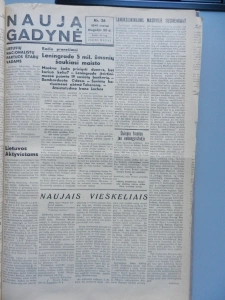
Jonas Noreika was an Iron Wolf (LNP) in sheep’s clothing (LAF).
Let us compare the July 20, 1941 resolution congratulating Lithuania’s Provisional Government with the three “Land of Samogitia” resolutions which Zenonas Blynas recorded. “The representatives of the community of the “Land of Samogitia”, having assembled on July 29, 1941 and familiarized themselves with the situation and evaluated it, [after the LNP / Voldemarist / Iron Wolf putsch on July 23-24,] decided to form a Samogitian delegation of these individuals: 1) Telšiai district LAF leader captain Noreika…” “The meeting emphasizes that among its participants were quite a few LAF members, previously active members of the Iron Wolf, who today as well stay true to that organization’s principles…” Jonas Noreika, having come to agreement with LNP, and having been granted its trust, pressured LAF to sign an agreement by which it would have ceased to exist. He even successfully demanded that, in organizing the new LNP staff, he would be named in the agreement as one of three advisors, along with the LNP representative and LAF representative, advising as to who should work in the new LNP staff. Telšiai LAF leader Jonas Noreika, in looking after his own future, betrayed the Lithuanian Activist Front, betrayed Lithuania’s Provisional Government, which he was supposed to congratulate, betrayed the people of the Telšiai area who sent him to Kaunas, and joined the enemies of Lithuania, the Lithuanian Nationalist Party. Zenonas Blynas noted, “Two members of the Samogitian deleg[ation] remarked that it was the case that they, too, wanted to liquidate those CaDems [Catholic Democrats]. Therefore we have nothing to fear from them.” Is it strange that LAF declined Noreika’s proposal?
What do you think, what did Jonas Noreika take to be LAF? In organizing the uprising, he kept in touch with LAF Kaunas. He also made several trips to Germany, and published and distributed LAF Berlin publications. Thus he had connections with LAF Koenigsberg, Klemensas Brunius and Stasys Puodžius. From LAF Telšiai staff chairman Leonas Vilutis’s memoirs we know that LAF Telšiai was, in fact, subordinate to a betrayer of Kazys Škirpa, major St.Puodžius of LAF Koenigsberg. “In the beginning of August there was received from the staff of LAF Kaunas an invitation for major Svilas to come to Kaunas. The major brought back an order in which it was informed that the Lithuanian Activist Front was abolished, and former LAF leader, general staff major Puodžius stepped down; the LAF staff was reorganized into the Lithuanian Nationalist Party. Engineer Klemensas Brunius was appointed the leader, J.Vokietaitis – the chairman of the organizational department; former LAF district leaders were appointed LNP leaders; the district staffs were reorganized as well.”
And this concurs with the testimony of the most illustrious Lithuanian organizer Klemensas Brunius. He named Jonas Noreika to the Soviets as first among Telšiai district LNP (!) leaders, and subsequently listed several other important LAF organizers: Stasys Bagdonas – organizer of the uprising; Alfonsas Svilas – successor of Noreika’s activity as LAF leader; and Kazys Mockus – editor of “Žemaičių žemė”. Klemensas Brunius knew Jonas Noreika for what he was, as the ruler of the Telšiai area in July, 1941, and so he conflated Telšiai LAF with Telšiai LNP. Why do you not mention Klemensas Brunius’s testimony in your certificate and your publications?
How can Alimas be guilty, but not Noreika?
And what was Jonas Noreika’s role in the genocide of Plungė’s Jews? In your certificate, you rely especially on Rev. Povilas Pukys’s testimony that Jonas Noreika had never actually been Plungė’s Commandant, but you don’t dare to share his crystal clear words, “At the Commandant’s Post, along with Alimas worked Noreika…” This concurs with Aleksandras Pakalniškis’s memoirs, that Jonas Noreika worked at the Commandant’s Post and ordered the genocide of Plungė’s Jews. You then go through three circumstances, which in your mind negate Aleksandras Pakalniškis’s assertions:
-
1) Jonas Noreika never was Plungė’s commandant.
-
2) Jonas Noreika does not figure in any testimony as the organizer or participant of the mass murders.
-
3) In the system of Nazi rule, Lithuanians were strictly in the position of subordinates.
What is strangest is that you assert in your certificate that, in fact, LAF Plungė leader Povilas Alimas – LAF Telšiai district leader Jonas Noreika’s subordinate – organized the shooting of the Jews and their conveyance to Kaušėnai! Moreover, you think that Noreika bears absolutely no responsibility for that. In that case, we don’t understand on the basis of what values we should try to come to agreement with you.
Who is more responsible than Jonas Noreika for the genocide of Jews of Telšiai area?
It was unclear to the Federal Republic of Germany’s prosecutors, who among the Germans was responsible for the mass murders of the Jews of Plungė and Telšiai district, in general. Thus in 1967-1970 they approached the Soviet Union for help on this matter. As we mentioned, Soviet security police found that the Plungė mass murders were led by platoon leader Stanislovas Lipčius and his deputy Povilas Alimas, and the Germans provided refreshments. In the mass murder of the Jewish men of Telšiai, only some 8 Germans participated, that is, one squad. This all concurs with Stahlecker’s October 15, 1941 report, from which it can be seen that a single Einsatzkommando 2 platoon (about 30 troops), responsible for the entire Šiauliai Kreisgebiete, managed to murder 42,000 Jews, whereas Jaeger’s Einsaztkommando 3 (150 troops) in Kaunas Kreisgebiete managed to murder only 32,000. The July, 1941 mass murders in Plungė and Telšiai occurred at a time when all mass murders in Kaunas Kreisgebiete had been halted. To cast the blame on the Nazi Germans is, in this case, akin to slander. The Telšiai District Chief Augustinas Ramanauskas and the Telšiai mayor left hundreds of documents which show that the Lithuanians themselves, without Germans, detained Jews, managed the ghettos, by their own orders led Jews out of them and back into them, and distributed their property even while they were still alive. In truth, the Jews of Plungė and Telšiai were detained in the very first days of the war, when the Germans themselves wished for Lithuanians to organize pogroms. And Jonas Noreika knew the wishes of the Germans because at the start of the war, German scouts drove him to a meeting in Klaipėda, from which he returned with permits to carry weapons, and with the news that the Nazis would not allow Lithuania to be independent. In that case, why serve the Germans? And for what purpose was it necessary to summons Noreika? It is simplest to think that the Einsatzkommando 2 unit which traveled through Klaipėda to Latvia conferred with him on matters concerning the genocide of Jews.
The Germans ceded the Telšiai area to the Lithuanian Nacional Zocialist police.
When will you publish the permit to carry weapons in
Telšiai district (Corrected reference: LCVA f.1075, a.2, b.3, l.3V)? It
is simplest to suppose that these are the permits which Jonas Noreika
brought back from Klaipėda, which Damijonas Riauka wrote about.  For
such permits were not easy to come by, and the Nazis would not have let
Lithuanians print them autonomously, nor would the Lithuanians have
dared to. Indeed, that had to be coordinated with the German army. What
other permits have you found that the Nazis issued to carry weapons? The
permits we discovered were meant only for Telšiai, as they had to be
signed by “The Lithuanian District Commandant – Die Komendantur
Telsche”. “The owner of this attestation ___________ is a member of the
Lithuanian Nacional Zocialist police and as such has the right to carry a
weapon.” What stands out is not only the typographical error “National
Zocialist”, but especially the term, “Lithuanian Nacional Zocialist
police”. It is clear that these permits were not intended for fighting
the Soviet army, nor for keeping order, nor for committing crimes under
German supervision. These permits were necessary so that Lithuanian
Nazis could convince the Germany army, as it passed through, that in all
of Telšiai district, Lithuanians had the right to autonomously
perpetrate crimes against humanity, and especially, to detain, plunder
and murder Telšiai area Jews.
For
such permits were not easy to come by, and the Nazis would not have let
Lithuanians print them autonomously, nor would the Lithuanians have
dared to. Indeed, that had to be coordinated with the German army. What
other permits have you found that the Nazis issued to carry weapons? The
permits we discovered were meant only for Telšiai, as they had to be
signed by “The Lithuanian District Commandant – Die Komendantur
Telsche”. “The owner of this attestation ___________ is a member of the
Lithuanian Nacional Zocialist police and as such has the right to carry a
weapon.” What stands out is not only the typographical error “National
Zocialist”, but especially the term, “Lithuanian Nacional Zocialist
police”. It is clear that these permits were not intended for fighting
the Soviet army, nor for keeping order, nor for committing crimes under
German supervision. These permits were necessary so that Lithuanian
Nazis could convince the Germany army, as it passed through, that in all
of Telšiai district, Lithuanians had the right to autonomously
perpetrate crimes against humanity, and especially, to detain, plunder
and murder Telšiai area Jews.
We know from Kazys Škirpa’s memoir [also the 1973 edition] that German Nazis did not let even the Voldemarists call themselves Nazis. The only one whom they allowed to lead a “Lithuanian National Socialist Party” was Plungė native Pranas Germantas-Meškauskas, friend of the most ruthless security policemen, Heydrich and Graefe. It is simplest to suppose that the Nazis gave the Telšiai area to Pranas Germantas-Meškauskas to do as he pleased with it, and Jonas Noreika realized his vision.
Autonomy on Jewish matters is demonstrated as well by the fact that after the main killings in July 1941, Lithuanians in the Telšiai area kept Jewish women slaves for a long time, even until the very end of December, 1941, after the celebration of the completion of the genocide of all of Lithuania’s Jews. The Telšiai authority on Jewish matters even told the women unofficially that on Monday (December 29th) their ghetto would be liquidated, and consequently, a couple hundred of them ran away, whoever had the strength. But the Lithuanians soon caught the greater part of them and shot them dead.
Why does your senior historian Stasys Buchoveckas, without citing any sources, purposefully paint Germantas-Meškauskas as a friend of Lithuania? The author does not suspect that it was Germantas-Meškauskas’s proposal which Heydrich considered in 1939, offering to conduct pogroms in Lithuania and overthrow the government. The author conflicts with the testimony of K.Škirpa, J.Keliuotis, Rev. St.Yla, R.Mackonis, Z.Blynas, A.Pakalniškis and L.Olšvangas, that Germantas-Meškauskas dreamed of being Lithuania’s Fuehrer and exterminating all of Lithuania’s Jews, was a faithful friend to R.Heydrich, H.Graefe and M.Kurmies – enemies of Lithuania’s freedom and of humanity, and had a special devotion to the Plungė region. The author does not comprehend that Dr.P.Germantas-Meškauskas, who earned his degrees in Nazi Germany, was a mentally distinguished sociopath, lacking a normal conscience, and thus capable of unreservedly doing terrifying evil and uncharacteristic good. He could at one and the same time lick the boots of President Antanas Smetona, Nazi security officers and the Provisional Government.
Let’s listen to Plungė residents and Jonas Noreika’s granddaughter Silvia Foti.
Why aren’t you interested in the testimonies preserved by residents of Plungė? In 1971, Stanislava Pocienė, born in 1907, told her son, then student Bronislavas Pocius, that in 1941, Jonas Noreika led the genocide of Plungė Jews, as Plungė Commandant. He had 20 henchmen (Lithuanian policemen, “whitebands”, who wore white bands on their arms). She heard that from people. In 1941, she worked in the Plungė factory as a spinner. Could you find the 2002 correspondence of historian Bronislavas Pocius and librarian Zita Paulauskaitė with you, in which you assert that that was “another Jonas Noreika”?
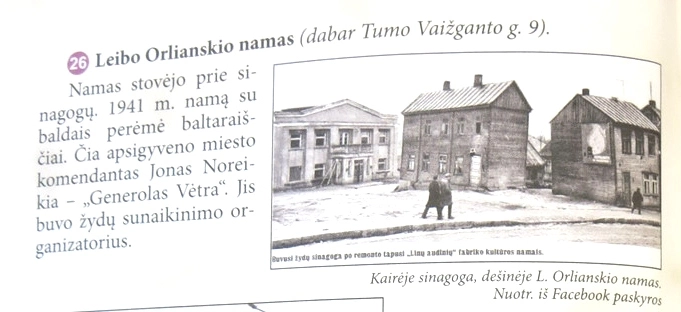
Have you been in Plungė with Jonas Noreika’s granddaughter Silvia Foti? Her aunt showed her the rich Jewish family’s house on Vaižganto g.3, where she would visit the Noreika family to play with Jonas Noreika’s daughter Dalytė. Have you determined whether the screams of the Jews who were tortured in the synagogue at Vaižganto g.7a could have been heard from their house? The aunt also showed in Šiauliai an elegant table for playing chess, with an inscription on the bottom in Yiddish. This concurs with Jewish intellectual Jakovas Bunda’s telling that Noreika took the finer furniture with him when he moved from Plungė to Šiauliai.
Aleksandras Pakalniškis conscientiously revealed the crimes of Noreika and his army.
You rely especially on Rev. P.Pukys’s testimony to the Soviets, although we find there many inconsistencies and even lies, which is understandable, as he wanted to avoid punishment for himself as well as others. Meanwhile, you delve not into Aleksandras Pakalniškis’s memoirs. You cite his book, Per dvidešimtąjį amžių, but he describes the same events in other books as well – Plungė, Gyvenimo pakelės and Septintoji knyga. Did you not notice that he himself got involved in the abuse of Jews? Indeed, he agreed to work at the Commandant’s Post knowing that all of the town’s Jews were being held in the synagogue. He recounts his view on the Jews at that time, similar to Jonas Noreika’s and Pranas Germantas-Meškauskas’s. He founded schools for the latter, hired genocide organizer Povilas Alimas as a physical education instructor, and played cards with the deciders of the fates of the residents of Plungė, Rev. Povilas Pukys and doctor Vladas Ivinskis, the brother of historian Zenonas Ivinskis. From Pakalniškis’s books it is clear that he is a marvelous witness who knew Plungė and its residents well, but especially, the activity of “Lithuania’s army”. He is intentionally silent about the crimes of his acquaintances and knowingly lies, repeating the LAF myth that Jews set Plungė on fire. And yet Pakalniškis correctly reveals the essence of the Lithuanian crimes, provides may details which are elsewhere confirmed, and conscientiously, clearly, persuasively and repeatedly tells how a meager German soldier, not even an officer, asked, “What do you plan to do with the locked up Jews?”, and how Jonas Noreika replied, “I have already given the order to shoot every last one of them.”
Have you investigated on what basis and for what purpose A.Pakalniškis’s testimonials are tendentiously disparaged? You published your certificate about Jonas Noreika on November 10, 2015, and in it you assert that the testimony gathered by Soviet security agencies negates A.Pakalniškis’s memoirs. One week earlier, on November 2, 2015, the esteemed professor Vytautas Landsbergis, of rank equal to Lithuania’s President, defended Noreika at the portal delfi.lt and belittled Pakalniškis:
The alleged order to shoot the Jews of Plungė is mentioned in the alleged memoirs of Lithuanian American Aleksandras Pakalniškis (published in 1995, Chicago). Supposedly on July 12-13, 1941, after the Plungė fire, Commandant J.Noreika told the Germans, regarding the Jews: “I gave the order to shoot every last one of them.” Pakalniškis tells it, as if he was a witness, who had heard and seen the dialogue, and even the German behavior. In truth, that episode was deceptively placed in the book by A.Pakalniškis or his publishers from an 11 year old publication (1984) in the magazine “Der Spiegel” (April 23, 1984), in which Šiauliai ghetto prisoner Leiba Lifšicas relates the alleged dialogue between Jonas Noreika and the German soldiers, which is later repeated word for word in the supposed “witness” A.Pakalniškis’s supposed “memoirs”.
In truth, the April 23, 1984 article „Die Mörder werden noch gebraucht“ was written by Leonidas Olšvangas, a Plungė Jew respected by both Germans and emigre Lithuanians. He notes A.Pakalniškis’s memoir “Plungė”, published in Chicago in 1980.
Why don’t you rely on the book which V.Landsbergis mentions, “Septintoji knyga”, published in 1995, in which Pakalniškis relates the events in Plungė in greatest detail? “In Plungė there was a Lithuanian Commandant’s Post. I became its employee because there was nothing else to do. And also I wanted to be closer to the latest news. Capt. Venclauskis sat in the same room as me. He was like a neighbor of mine, in that he had a farm in Juodeikiai, and our lands bordered each other. He was the father-in-law of Purvinas from Klaipėda. In the next room sat the Commandant himself, young Capt. Noreika. Often Capt.Lipčius would come by to the Commandant’s Post. He had a beard and a motorcycle, and maintained contact between Plungė and other towns. … Two German soldiers would also come by to see the Commandant. Somehow they had been left behind in Plungė. On our sleeves we had white bands with black letters “TDA”.” Why don’t you rely on Pakalniškis’s interview with Akiračiai? Or on his diaries, which are kept at the ALKA archive? Have you ascertained what was in the archival boxes Nr.1 and Nr.2 and why they happened to be the boxes destroyed by the flooding in October, 2016?
What is your judgment on the mobilization into Lithuania’s army which was ordered in the Plungė region? Pakalniškis not only describes those who served in Plungė – Capt. Jonas Noreika, Capt. Stanislovas Lipčius, Lieutenant Povilas Alimas, Capt. Kazimieras Venclauskas, Sergeant Pranas Šapalas and Arnoldas Pabrėža – all of whom participated in the abuse and genocide of Jews. He also draws attention to the fact that the village aldermen forcibly mobilized the youth of the surrounding areas, and he correctly calls it “Lithuania’s army”. Indeed, Nazi Germany had no right to mobilize the residents of occupied Lithuania. Village elders forced men in the name of the Republic of Lithuania to serve in the Plungė company and Telšiai company. They immediately distinguished themselves in the genocide of Jews. In the fall of 1941, one soldier joined because there was no other way for him to provide his family with ration cards. Major A.Svilas, who succeeded Noreika as Telšiai LAF leader, threatened another soldier that if he did not sign up, then he would deport him to Saxony to work as a slave.
Telšiai district soldiers wore Lithuanian army uniforms with Lithuanian insignia. They were armed with rifles and pistols. Soldiers enlisted in the T.D.A. and that is how they called it. There are blank forms in which the wish to enlist in the T.D.A. platoon was made to the leader of the L.N.P. “Iron Wolf”. At the same time they filled out a sheet, “L.N.P. Defense of National Labor (TDA) Member’s Information”. There is the TDA enlistee’s oath: “I swear to faithfully and conscientiously perform the “TDA” member’s duties, and bearing the name of an elite Lithuanian, I will work for the welfare of my nation and will fight for its endeavors. …” There is also the “Iron Wolf” enlistee’s solemn oath: “I solemnly swear that I will faithfully and conscientiously perform the “Iron Wolf” member’s duties, will defend the Lithuanian nation’s right and honor, and sparing neither my life nor my powers will work for its welfare…” There is a declaration to the Telšiai T.D.A. Officer’s Club’s Council. In none of the forms or oaths is there any mention of Hitler or Germany to whom the Auxiliary Police Battalions pledged allegiance elsewhere in Lithuania. The rebels in Telšiai district were not disarmed, as in the rest of Lithuania. They kept their weapons until January 1, 1942. Even the call for volunteers to enlist in the Lithuanian Self Defense Units on February 6, 1942, as announced by Telšiai District Chief A.Ramanauskas, makes no mention of Nazi Germany. Where do you emphasize Lithuanian responsibility for these units?
Lithuanian responsibility is made manifest by the “Telšiai City Defense of National Labor Platoon FOUNDING ACT” published in “Žemaičių žemė”: On October 14, 1941, the leader of the Iron Wolf in Telšiai convened a meeting of the like minded in Telšiai regarding Lithuanian national labor. Those present, having heard a report by the Iron Wolf Leader and having discussed the need for Lithuanians to unite in order to help, in an organized fashion, the Lithuanian Nationalist Party to strive for cultural and state aims, decided to enliven the activity of the Telšiai city Defense of National Labor by forming, in the form envisaged by the L.N.P leadership, a T.D.A. Telšiai city platoon. Working in the Defense of National Labor, we pledge to be tireless promoters of its ideas and executors of the orders of the national Lithuanian leadership.” Where are the Germans? And why doesn’t A.Bubnys in his book about the battalions not bring to light all of these documents, nor emphasize the autonomy of Telšiai area Lithuanians?
Noreika was the highest authority in Telšiai district.
You acknowledge in your certificate that Jonas Noreika was guilty in contributing to the judicial persecution of individuals who collaborated with the Soviet occupying regime in 1940-1941. You note that he along with others made a ruling to sentence Jurgis Endriuška to three months imprisonment in a labor camp. It must be said, you neglect to state that Endriuška received such a sentence for directing a choir. Why did you not review all 270 court cases in the LCVA f.R-1441, a.2 catalog? Indeed, these catalogs make clear the unusual autonomy which Lithuanians had in Telšiai district, in the name of the Republic of Lithuania, as well as Telšiai LAF leader Jonas Noreika’s role in granting and rejecting requests for pardon. We know that the eminent forester Aleksandras Tenisonas’s wife “died tragically” in July, 1941. It turns out that “IN THE NAME OF THE REPUBLIC OF LITHUANIA, on July 19, 1941, in Telšiai”, a battlefield court sentenced her and 11 others to death by the laws of Lithuania. Her request for a pardon was rejected by the Lithuanian Activist Front staff in Telšiai, which is to say, Jonas Noreika. The next day in Telšiai he celebrated the great manifestation of unity. There is prosecutor B.Antanėlis’s instruction of July 20, 1941: “Please hand over the ones to be executed to the guards in the platoon of reservists [Šauliai] which has come.”
The cases of the battlefield court help us understand bishop Vincentas Borisevičius’s testimony, “with the now deceased bishop [Justinas Staugaitis] we used to send priests to mediate so that Communists would not be executed. We succeeding in saving 5 people: Žutautas, Abramovičius and others.” From the details it becomes apparent that Algirdas Žūtautas was one of four Soviet officials of the Telšiai prison who, at the start of the war, considered which of the prisoners to keep alive, and which ones to kill in Rainiai forest.
On July 19 the Telšiai Activist staff granted Žūtautas’s request for a pardon, but rejected the requests of five prison guards, and thus executed the witnesses of the fate of the Rainiai victims. It’s interesting, under what conditions did Jonas Noreika satisfy the bishops’ requests? For the very next day High Mass was part of the “Land of Samogitia” manifestation of freedom.
Šiauliai lawyer Matas Krygeris learned of those condemned on July 19, 1941 in the following manner:
In some places, brother Lithuanians conducted executions of their own initiative. In particular, in Telšiai there formed a Lithuanian “battlefield court” of superpatriots, which tried “Communists” and “activists on behalf of Communists”, and executed its own sentences. One of the condemned, Vladas [Bauža], born in 1909, in July, 1941, along with 14 other “Communists” was transported out of Telšiai to be shot. In executing the sentence, he was placed with the others aside a pit. Upon hearing shots, he got spooked and fell into the pit, and then some two hours later he crept out of it and ran away. … I drove to Telšiai to ascertain what was going on. At the Lithuanian Activist Front headquarters, [Bronius Antanėlis], who titled himself “the battlefield court” prosecutor, introduced me as the Šiauliai province prosecutor, who had come to confer regarding those being held. I openly declared to those present:
– I think you have concluded for yourselves that a second, Hitlerist occupation of Lithuania has taken place, which promises no good. I disapprove of the “battlefield court” you have organized and its death sentences. … The LAF Telšiai staff held many detainees in one barrack and the Telšiai jail. I suggested to release them before the Gestapo got a chance to take them into its own custody. There were none who objected. Augustinas Ramanauskas, who later became General Councilor for Agricultural Affairs, added: “I told you that what we’re doing is wrong.” (“Rūstūs prisiminimai”, 1994, p.50-51)
Why don’t you publish Jonas Noreika’s order of July 25, 1941 (LCVA f.1075, a.2, b.6) and lay out its circumstances? It must have been a consequence of Krygeris’s intervention. From Noreika’s order we see, as with the requests for pardon, that Jonas Noreika was the highest authority in Telšiai district, higher even than District Chief A.Ramanauskas, who had said, “what we’re doing is wrong”. The order “To Telšiai District Police Station Chiefs and Activist Staffs” underscores, “It is strictly forbidden to hand out death sentences and execute them on the basis of local initiative. In transporting detainees you must prevent any chance of escape, and any reports that “the detainee was shot while fleeing” will be rigorously investigated. Criminal charges will be made for any such self-initiative.” From Noreika’s order it is clear that there were such death sentences throughout the entire district and that both policemen and activists conducted them. We note especially that L.Activist Front Leader Capt.Noreika signed first, and Telšiai District Chief Ramanauskas signed second. This again shows Jonas Noreika’s primacy in matters of life and death. Therefore we assert that Jonas Noreika’s criminal gang acted in the names of the Republic of Lithuania, the Lithuanian nation and “The Land of Samogitia”. It also called itself LAF, LNP, TDA, “Iron Wolf”, Apartment Bureau, Samogitian Legion and the 14th Battalion. Noreika’s criminal gang by its own authority arrested and held Jews and Lithuanians, sentenced them, granted and rejected their pleas for mercy, and by its own authority executed them.
The white-bands held the Jews of Alsėdžiai village, then tortured and murdered them. Where have you written up all of the activists who were subordinate to Jonas Noreika, their activity and their crimes?
In Plungė, there also functioned a Lithuanian court, where fates were determined by Plungė’s authorities, policemen, Alimas’s wife Alimienė, Rev. P.Pukys, doctor V.Ivinskis and others. In all about 140 Lithuanians were executed in Plungė. It may be supposed that in one month, in Telšiai district, about 300 Lithuanians were shot dead. What do you think, how many Lithuanians did the Lithuanians shoot dead while Jonas Noreika led LAF Telšiai?
Jonas Noreika was morally obliged to save Lithuanians and Jews.
In this matter, we can call the Germans the rescuers of Lithuanians. Pakalniškis relates how, on August 5, 1941, a German rescued Juozas Jankauskis by asking, “How old is he?” and then saying about the 23-year old man, “You can’t shoot such young ones, they don’t yet have a brain. Stop these killings for once.” Leonas Vilutis immortalized LAF’s sick view of the murders: “The Telšiai prison partisans (the reservists) held over one hundred Communist activists they had captured who had committed heavy crimes against the Lithuanian people. The judicial organs investigated their cases and the guilty were tried. The German Commissar Gewecke, as representative of the province, suspended the investigations and freed the Communists, without considering their crimes, when he assembled the population [on August 28, 1941] in the market square and declared an amnesty. For he had the purpose to sow hatred among Lithuanians, to draw to his side the criminals, and to provoke the Judases, who would snitch on those people who had brought them into prison.”
Matas Krygeris by his brave example shows us all how Jonas Noreika could have and should have behaved.
Revolted by the Hitlerist killings, on July 29, 1941, I addressed the district chiefs of Šiauliai, Telšiai, Raseiniai, Tauragė, Mažeikiai and Kretinga with Document Nr. 85, suggesting that they stop the unwarranted arrests and executions of Lithuanians. In the circular, I pointed out that “annihilation of the Lithuanians who had worked in Bolshevik institutions was annihilation of the Lithuanian nation itself, and such endeavors of vengeance are to be most harshly rejected.” Some of the district chiefs sent copies of my circular to their police station chiefs and this had a positive influence on them. I knew that I could suffer for this, yet I resolved to do so.
It is interesting that both the Soviets and the Nazis respected Matas Krygeris that he defended Lithuanians so. And yet the Lithuanian murderers themselves reported him, and he had to spend a good year in the SD prison in Tilsit. What is needed to acknowledge Jonas Noreika’s unbridled rule and come to doubt the fruits of his “anti-Soviet” and “anti-Nazi” activity?
Jonas Noreika did not resolve to save deported Lithuanians.
Did Jonas Noreika care to save people or to oppress them?
His comrades such as Antanas Juočeris, in preparing for the war, accumulated a number of weapons, including dynamite.
Telšiai police officer’s wife Ona Algminienė relates in her novel based on reality, “The Red Blight”:
“…armed activists are preparing, somewhere near the forest, to stop the train with our people and free the detainees from the wagons. They have no doubt of success – it would be no matter to defeat the armed Asiatics in a fire fight. … Having considered all of the plans for the attack, the underground fighters – activists did not forget to consider the possible consequences as well. True, they would free those being deported, but the whole city might be held accountable, and possibly – the whole district. Should Stalin send an army of “exterminators”, all would be leveled to the earth. Therefore they decided not to execute their plan.”
Her son Liutavaras L. Algminas confirmed that all of the events in the novel were based on facts.
Jonas Noreika and his comrades wanted to come to power. For this reason they declined to fight a just fight, but awaited instructions from Nazi Germany.
Jonas Noreika’s underground press fostered hatred.
We know that Jonas Noreika was one of the few organizers of the rebellion who had ties with Kaunas LAF, with Koenigsberg LAF, and with the Germans themselves. He was extremely secretive. It is remarkable that Leonas Vilutis, who wrote about the Telšiai rebels in such detail, makes no mention of Noreika, although, truth be told, he makes no mention either of the Telšiai manifestation, Kazys Mockus and “Žemaičių žemė”, or the mass murders of the Jews. However, Vilutis does write of Noreika’s deputy Juodikis, who also maintained ties with Germany: “From S.Bagdonas I learned that teacher A.Norkevičius and Juodikis also knew about my activity at school. Later I understood that this officer was considered the most important organizer of the underground. Therefore official ties with him were avoided.” A similar secretiveness arises in Adomas Jurgelis’s account of how he distributed rebel publications, which he got from Juozas Mėčius. Jurgelis wrote down his recollections on August 25, 1941, and yet he intentionally did not name one very important person: “That same day [June 19] there came from Kelmė the high school student Jurgis Matula, who used to say that he had contacts even with …” It is likely that that person was Jonas Noreika, but however it may be, Jurgelis names the same circle of underground press distributors which Kaunas LAF organizer Pilypas Žukauskas-Narutis associates with Jonas Noreika, namely Juozas Mėta (that is, Mėčius) and Stasė Vanagaitė. And we know from Damijonas Riauka that Jonas Noreika in Plungė published leaflets with a sizable circulation of 500 to 1,000.
Jurgelis writes: “Rev. Velavičius calls on March 23rd. I promptly harness the horse, mount and ride. I get the March 19th declaration for printing. He says that he got but a single copy. I get back soon and we print them on the morning of March 24th, and we drive them to Telšiai, Varniai, and other places mentioned earlier. Having read the March 19th leaflet we decided to better organize ourselves.” It is clear that he’s referring to the leaflet “Dear slaving brothers“, all of whose variants have these words: “Today, this very day, inform the Jews that their fate is clear. Therefore, whoever so can, would best get themselves out of Lithuania, that there be no unnecessary victims. In the fateful moment, take their wealth into your own hands, that nothing perish in vain.”
We know from Varniai LAF staff leader Jurgelis, how that all ended: “Also, on Monday [June 23rd] we already started to arrest the Communists most dangerous to us, so that they would not have contact with the Red Army. On Tuesday, having noticed them in the forest, we go after the Communists of Varniai, such as the members of the Executive Committee, the Communist Party, and others. We seize them, put them in the bathhouse of farmer Povilas Martinkus in Pakalniškiai, and we place a guard.” Whom do you think such arrests served more: Lithuania’s independence or Nazi Germany’s politics of occupation?
Why have you not investigated what Jonas Noreika published, and what were the consequences?
Jonas Noreika united society in criminal activity.
In the Telšiai area, Jonas Noreika conducted the genocide of Jews on a scale which brings to mind Pranas Jakys in the Kretinga area and Petras Požėla in the Šiauliai area. However, he exceeded them in his ability to unite all of society in criminal activity. It is therefore important to teach the youth how to recognize and reject such immoral temptations by a proclaimer of unity.
In the beginning of July, Jonas Noreika was already organizing intellectuals to organize manifestations. The Telšiai choir was established. It traveled through Samogitia along with speech makers – former Soviet political prisoners. Crowds in the thousands thronged in Telšiai, Plungė, Nevarėnai, Varniai and Pavandenys. At the height of the Holocaust, a water sports festival was organized in Telšiai. Noreika handed out medals. Soviet books were burned in bonfires. Theater troupes amused the people, we should suppose, with the most despicable jeers. In reading the horrible editorials and counting the corpses, one inevitably perceives an intentional incitement of hatred.
The Council of Arts which was formed under the Telšiai District Chief was so important to Noreika that it was promptly transferred to the L.A.F. propaganda unit, “where it will work in the greatest contact with our dashing activists”.
Lithuanian society was unified by publicly mocking Jews. A.Pakalniškis describes the actions of the Republic of Lithuania’s recruits. “Armed soldiers drove the Jews on as if they were prisoners, and to increase the derision, a Jew had to walk in front, holding a red Communist star in both hands, raised high. The once wealthy Jews of Plungė, the former owners of the large stores, and later the managers of those stores, were now herded about town in this way.” In Plungė, even the guards of the “Mastis” factory got involved in the murder, just for the sake of trying out their weapons, as the Jews passed by on their way to be killed.
Lithuania society was also greatly unified by divvying up Jewish wealth. Hundreds of documents to and from the Telšiai District Chief and Telšiai Mayor painfully bear witness how Lithuanians distributed and appropriated the wealth of the victims of the mass murders, along with responsibility for those mass murderers. Lithuania’s Provisional Government encouraged this with edicts, rulings and ordinances, just as Jonas Noreika encouraged this with his personal example, coveting a Jewish family’s house and furniture.
The Telšiai District government, police, army and activists acted in unity to apprehend concocted “enemies”, Jews and Lithuanians. United, they managed the Jewish ghetto and forced Jews to work as slaves. United, they convened a battlefield court, handed down death sentences and executed them. United, they carried out the orders of the Provisional Government. They did it all in the name of the Republic of Lithuania, in the name of “the Land of Samogitia”. United, they disgraced the name of Lithuania, Lithuanians and Samogitians, so that subsequently it is hard for us to stand straight again.
Jonas Noreika sullied the servants of God, the bishops and priests of the Telšiai diocese, with crimes against humanity. The Soviets appropriated the Telšiai diocese’s printing press, but the rebels did not return it, and so it belonged to “the Lithuanian government”. Catholic press editor Kazys Mockus edited “Žemaičių žemę”. Have you figured out who were this newspaper’s participants? Unfortunately, the diocese did not distance itself from the newspaper. Cathedral organist Ferdinandas Jankauskas worked for the editor. Articles were contributed by “Žemaičių prietelius” editor Rev. Kazimieras Olšauskas, Telšių cathedral pastor Rev. Pilypavičius, Leonas Vilutis and Petras Gintalas. It should be supposed that the nucleus of the newspaper consisted of the participants of the Telšiai Catholic newspaper “Žemaičių prietelius”. The publisher was Samogitian Activists, and later, Samogitian. L. Activist Front, which is to say, Jonas Noreika was responsible. Why did the diocese not object that “the Lithuanian government” used its printing press to incite mass murder? Why did it let innocent Jews be tortured and demeaned during the funeral of the Rainiai victims? Why did it forgive the murderers their sins? For that is the inappropriate use of a spiritual weapon. How have you investigated the role of the Telšiai diocese in the Lithuanian crimes of 1941?
Jonas Noreika spiritually desecrated Jewish victims.
Why don’t you emphasize the Lithuanian torturers’ brutality and the Jewish victims’ innocence? For only then is it possible to understand and name Jonas Noreika’s cruelest crimes, which tortured not only body, but spirit as well. The great rabbi Avrahamas Icchakas Blochas of the Telšiai yeshiva was a victim of exceptional holiness. In the face of Telšiai LAF crimes, he devoted himself to God, prayer, study of the Torah and education. When he was pummeled on the head with a hammer “to knock God out of him”, he proclaimed, “God is for all”. Why does the state of Lithuania not resolve to immortalize his martyrdom in Telšiai so that we might all learn from him as from a victor?
In the first days of the war, Jonas Noreika’s subordinates, the Samogitian activists, inhumanely crammed 1,800 Plungė area Jews into the Plungė synagogue, with the result that at least four children were crushed dead, and some of the adults went mad. For two weeks, Lithuanians tortured their body and spirit: they gave them nothing to eat, nor to drink, they burned Scriptures, and would lead Jews out to mock them, rape Jewish women, shoot at the synagogue windows, shoot through the doors, beckon the sick and then take them away to shoot them dead, force Jews to eat manure, and burn Jews alive.
Plungė Jews were marched to the foot of Rudelis hill to dig themselves pits. The priest Lygnugaris drove over from Plungė saying that he could not save the Jews but he could baptize them before they died. He brought a bucket of water and baptized the Jewish maidens, according to one testimony, 74 high school girls. Arnoldas Pabrėža and his Lithuanian subordinates then raped and killed them. [Correction: These maidens were not raped. However, in late July, Pabrėža and his Lithuanian subordinates tortured, raped and killed four Jewish maidens.] Jonas Noreika must be held responsible for the martyrdom of these girls, the breaking of their spirit and the desecration of their bodies. They are completely pure and the truest martyrs. Why is their martyrdom not named as such? What do you think, should the Roman Catholic Church not cast them aside, not forget them, not demean them but recognize them as Catholic martyrs? Should not the state of Lithuania regard them as Lithuanian martyrs? Who in their homeland appreciates their holy sacrifice?
Jonas Noreika spiritually desecrated Lithuanian victims.
Jonas Noreika also spiritually desecrated the 75 Lithuanian prisoners who were murdered by the Soviets in Rainiai. Jonas Noreika’s criminal gang intentionally distorted this horrible tragedy in order to justify its own murderous fantasies. Where have you investigated Lithuanian responsibility for exaggerating their torments? Lithuanians to this day necessarily emphasize the unrivaled brutality of Soviet torture. In your website, you acknowledge that, “What subsequently happened, is not well known. In Lithuania, these were perhaps the only murders after which not a single witness survived.” Why don’t you mention in your website that the witnesses of these murders, the Lithuanian prison guards, were shot dead by that gang which called itself the Republic of Lithuania, Jonas Noreika having rejected their pleas for clemency?
The Republic of Lithuania published in its press the Telšiai activists’ mendacious, mass murder inciting fabrications. For example, the Provisional Government’s Agricultural Palace’s published weekly, “Farmer’s Advisor”, mendaciously declared on July 25, 1941, “The skin of some was torn off their heads. Leather belts were cut from the backs and breasts of others. The eyes of some were burned and the entire skin of others was scalded. The ribs of some were broken and their hands were tucked inside their guts. The sexual organs of many of the men were cut off and stuffed in their mouths. And the women were burned with a hot iron. The breasts of some of the women were cut off and tied to their ears. There were others who were tortured to death in even more cruel and disgusting ways. From the ways they were tortured and the from the various outer marks on their bodies it can be concluded that all of these people where tortured with the absolutely cruelest torments, such as could be invented only by the blood thirsty Asiatics’ perverted imagination.” These imagined torments and the overall system of torture were partially ascribed to the Jews with the purpose of justifying that they be plundered and killed off. When will the Republic of Lithuania determine who spread this lie and will start to resolutely regret this lie? Why have you not published at your website that the medical protocol written by doctor Plechavičius and the 1988 testimony of his assistant, Vaclovas Rubinas, negate the tortures concocted in the Lithuanian press?
Why is the Republic of Lithuania afraid to speak up that the murder of the Telšiai Lithuanian prisoners was a consequence not only of the indefensible Soviet cruelty, but also Nazi Germany’s unexpected and no less bloodthirsty attack? Why has the Republic of Lithuania not condemned the war which Nazi Germany started? Does the Republic of Lithuania assert, as did Lithuania’s Provisional Government, that Nazi Germany saved Lithuania with its invasion? Who disoriented the Republic of Lithuania?
Where do you emphasize that LAF Telšiai in its lies and brutality held its own with the Soviets? Lacking witnesses, how can we at all trust Jonas Noreika’s comrades that the corpses, already rotting, which they unburied, were tortured to death, rather than mutilated when they were buried on the morning of June 25th or unburied on June 28th? What court of law would accept their testimonies, which are negated, for example, by Vaclovas Rubinas, who, working with doctor Plechavičius, wrote down descriptions of the dead bodies?
Plechavičius inspected about half of the corpses and I wrote down the mutilations of about half of the corpses as he dictated them. … All of the bodies were bound. They all without exception had their hands tied behind their backs. Their mouths were bound and their hands were tied behind their backs with cloth ties. I don’t recall any of them being bound by barbed wire or any other wire. In the group of bodies that I described there were none whose sexual organs were cut off. The sexual organs of almost all of them were battered. I recall that two or three of the bodies were shot through. There were eyes which had fallen out of their sockets, there were battered heads, and for others, their brains were protruding. … The corpses had started to rot, as I mentioned already, and an unpleasant smell emanated. … Doctor Plechavičius did not speak of scaldings or nails hammered in. The corpses had started to rot and one could have gotten the impression that they were scalded, and the skin could have peeled off. As I recall, it was being said that the bodies were unburied the previous evening, that is, on June 26, 1941.
The Soviets acknowledge that they killed the prisoners. But if they mutilated them alive, then why didn’t they leave the bodies in place for all to see? Doesn’t it seem to you that Telšiai LAF got lucky in that, by a strange coincidence, they discovered the corpses immediately after they finished driving the Jews into the Rainiai estate on June 27-28 ? Therefore they were able to force the Jews to wash the corpses and even shoot on the spot the Jew Dampis, who refused to wash them. Why in your book “Rainių tragedija 1941 m. birželio 24-25 d.” (2000) do you reproduce, without comment, mendacious claims, such as Ranas Sabaliauskas’s assertion that he himself saw how the prisoners were tortured in the forest? Or perhaps you think that Lithuanians knew from the very beginning where the bodies were, but kept quiet about it? Why is it that Ranas Sabaliauskas is the one who personally witnessed that lie, which “The Farmer’s Advisor” spread? Why do you with your publication spread this lie further, without comment?
Why in your publications do you forget, as do Šiušaitis, Urbanavičius and Landsbergis in their exhaustive book, “Pamirštas SSRS karo nusikaltimas. Rainiai 1941 06 24-25.” (2007), the words written on the prisoner’s bowl, which the Telšiai battlefield court saved, and which end, “Heil Sieg! Deutschland ūber alles! You saved our parentland Lithuania from the claws of Asiatic predatory Bolshevik bandits and established a new government of our own people, true Lithuanians, on strong steel foundations.” Do you believe that that bowl and the 239 word text on its outer wall were truly authentic?
Telšiai LAF leader Jonas Noreika is responsible for using the murdered Lithuanian prisoners to incite and justify crimes against humanity. He replaced sadness with disgust. The Jews held by Telšiai LAF were forced to unbury and wash the rotting corpses and to drink the washings, and were shot dead that same day. Then on the day of the prisoners’ funeral they were forced to publicly repent. It is clear that LAF Telšiai did not behave this way out of revenge against the Jews, but out of a desire to do as it pleased and to justify the genocide of Jews and the distribution of their wealth which it already foresaw. Jonas Noreika is responsible for the discrepancy between the reality and the myth of Rainiai martyrdom, the lie by which he and his comrades covered up their own terrible crimes, and which even in our own times further damages Lithuanian and Jewish relations. Jonas Noreika’s criminal gang spiritually mutilated and to this very day mutilate 75 victims which the Soviets murdered.
Jonas Noreika was best suited for the crimes envisaged in the Šiauliai area.
Šiauliai District Chief Ignas Urbaitis showed by his behavior how Jonas Noreika should have behaved. There exists his July 25, 1941 letter to the Mayor of Šiauliai.
I forward to you the request of the residents of the city of Žagarė that ethnically Jewish citizens not be transferred from the city of Šiauliai to the Žagarė old town and I ask you to pay attention to the serious rationales they provide and to draw the necessary conclusions. (LCVA f.R-1099, a.2, b.92)
I.Urbaitis’s family recalls, and the interrogation of Urbaitis confirms, that from the very first days he tried in every way to give up his criminal duties. In perversely fostering the cult of Jonas Noreika, you slander a righteous person, and thus you impel the revelation of not only the crimes against Jews committed by Noreika, who replaced I.Urbaitis, but also those of Juozas Brazaitis-Ambrazevičius and Lithuania’s Provisional Government.
I.Urbaitis telephoned to Kaunas to inform them that he did not want to be Šiauliai District Chief. Receiving no reply, on July 14th he wrote himself an order to travel to Kaunas on July 18-19, and so the July 18th edict for transferring the Jews, which you mention, was signed by his assistant. In Kaunas, I.Urbaitis explained to Internal Affairs Minister Šlepetys that he did not want to be Šiauliai District Chief. From that time onward, I.Urbaitis stayed in his office not by his own will, but by the will of Lithuania’s Provisional Government. In sending him back to Šiauliai, it takes responsibility for all of the Šiauliai District’s decrees regarding the Jews, including the decree which I.Urbaitis signed on July 23rd about wearing the Star of David.
Consequently, Lithuania’s Provisional Government’s Statute for the Jews’ Situation are significant for Šiauliai District and all of Lithuania. Juozas Ambrazevičius discussed them in his letter to Zenonas Ivinskis on May 23, 1971:
A special case is the Provisional Government and the Jews, for which a ghetto was established according to the published collection of the Provisional Government’s decrees. I would draw attention to the following facts regarding that ghetto: (a) The collection of decrees was declared not by the Provisional Government, but on the initiative of one of the First General Councilor’s officials; (b) the alleged decree for establishing the ghetto is placed at the end of that collection, as the last one with the signatures of J.Ambrazevičius and Šlepetys (Internal Affairs Minister), whereas all of the other decrees or resolutions were proclaimed with the signatures of Ambrazevičius and the Manager of Affairs (J.Švelnikas). This difference encourages us to come up with a reason why for that difference. And that “difference” accounts for the real path of that ghetto decree. Namely: the Germans demanded a ghetto from Commandant J.Bobelis. J.Bobelis explains that he must get a ruling for that from his government. He prepares a draft with the signatures of Ambrazevičius and the Internal Affairs Minister. That draft was discussed on several occasions and ever postponed. The ruling not forthcoming, the Germans established the ghetto of their own initiative. As an issue, the decree lost all relevance. And so it remained among the papers as a draft, not as a ruling. (VU f.198, b.972)
Ambrazevičius’s excuses nevertheless confirm that the Provisional Government seriously considered how to oppress Jews in all of Lithuania in the name of the Republic of Lithuania. It was choosing the state crimes proposed by J.Bobelis, from which it was saved only by the Voldemarist putsch. Zenonas Ivinskis recounted the longstanding impact of these decrees:
It was later easy to verify how comparatively many new laws, decrees and regulations the LPG [Lithuania’s Provisional Government] passed and proclaimed from that collection which already in the Fall of 1941 the First Councilor’s Gen.Kubiliūnas’s agency published in Lithuanian and German for its civil service. The new administration could not ignore what the LPG had done, and basing itself on the protocols of the Minister’s Cabinet and their appendices, all manner of newly passed laws and decrees, it codified them for its own purpose. 8) This work, in accordance with the LP Government protocols, was fastidiously performed by Kubiliūnas’s Chancellery’s lawyer Montvila. (VU f.198, b.917)
And, in fact, the Kaunas ghetto was established on July 25 by the Lithuanian Voldemarists, the Lithuanian Nationalist Party, immediately after the putsch against J.Bobelis. During the putsch, the Voldemarists also detained Minister Šlepetys and held him hostage. Under such circumstances, Noreika came to Kaunas. Major Svilas suggested him to Ambrazevičius. Noreika understood full well what the Holocaust was, and readily agreed to perpetrate it in Šiauliai. At the same time, it was useful for Lithuania’s Provisional Government to woo him out of Kaunas, for right away he conducted against it the harmful politics of the Lithuanian Nationalist Party. Thus we read in Zenonas Blynas’s diary entry of August 1, 1941, “There’s news that the Cabinet offered Capt. Noreika the position of Šiauliai District Chief. Thus men are “liquidated”. Give them credit, it’s quite a fight.”
And under what circumstances did Minister Šlepetys sign his appointment of Noreika? Blynas writes, on that same day, August 1, 1941: “Reivytis – the police chief – came about 14:00. There were Taunys, Brunius, Stanevičius. Those 4 spoke about liquidating Šlepetys. They wrote up a letter that Šlepetys resigns as of this August 1st and hands over his office to Major Puodžius.” All of the people named above were supporters of the genocide of Jews. The next day, August 2, 1941, Blynas writes: “Everything’s fine with Šlepetys. He joined us. He’ll do what we want. According to him, the Germans are imposing (or will impose) Raštikis and Meškauskas-Germantas upon the Cabinet.”
Putting it all together, Lithuania’s Provisional Government suggested Jonas Noreika as Šiauliai District Chief with the purpose of getting him out of Kaunas, where he was harming it with his activity with the Lithuanian Nationalist Party. He was well suited for those duties because he knew that the Jews would all be murdered and he supported that. And Minister Šlepetys appointed Noreika only after he gave in to the Lithuanian Nationalist Party and its genocidal program.
Jonas Noreika dutifully “isolated” Šiauliai district’s Jews.
Do you agree that the isolation of people is a crime against humanity? It conflicts with Lithuania’s constitution. I believe that the state of Lithuania and its citizens will agree that it is unacceptable. Indeed, those who assert the opposite undermine Lithuania’s statehood.
Is it acceptable to you that in 2015, esteemed professor Vytautas Landsbergis, the legal equivalent of a President of Lithuania, defended Jonas Noreika with the following thoughts?
The LGGRT Centre distinguishes between the isolation and annihilation of people. The current accusers of Jonas Noreika do not make this distinction. Isolation from other residents can also be called segregation. (The Russian empire, the Republic of South Africa, the US war with Japan and other instances.) In the countries occupied by Germany, in executing the inhumane Hitlerist doctrine of “cleansing” Europe of Jews, the Jewish nation’s segregation was followed by annihilation. The Gypsy’s as well.
Perhaps the professor’s father, Utilities Minister Vytautas Landsbergis-Žemkalnis, thought similarly about “isolation” and “separation” when on June 27th, Lithuania’s Provisional Government assigned to his Vice-Minister the task of setting up a concentration camp, one should think, at Kaunas VII fort, where within less than a couple of weeks, on July 4-6, the Voldemarists relished in the murder of 3,000 Jews. In those days, Finance Minister Jonas Matulionis laid it out to the Jews as follows:
I am a practicing Roman Catholic. Like other believers, I think that one person may not take away the life of another person, such as himself. Only God has such a right. I never was predisposed against anybody, however, during the Soviet occupation, I and my friend came to understand, that our path and the Jews’ path differ and will never coincide. It seems to us that Lithuanians and Jews should be separated from each other, and the sooner, the better. The ghetto is necessary for this purpose. There you will be separated from us and no longer able to harm us. This is the opinion of a Christian.
On July 11, Kaunas archbishop Juozas Skvireckas thought as follows:
The Jews had tried to find defenders and had even visited bishop Brizgys, who explained to them, that the Jews probably know of the Catholic clergy’s position regarding the Jews, but if they were now to attempt to publicly speak out for the Jews, they could be lynched themselves [by the Lithuanians]. It goes without saying that not all Jews are guilty, but the guilty ones incurred the enmity of Lithuanian society upon all Jews, in general. The Jews should understand at this moment that there is no reckoning by which they must necessarily force themselves upon Lithuanians to be amongst them, but that it would be better for their own sake if they calmly remained alongside Lithuanians in the places assigned to them, that it would be for them, let us say, calmer in Panevėžys or Šiauliai, where there were no excesses against them, than in Kaunas, into which some 8,000 Jews from all lands have wandered in recent times.
Do you think that the isolation of Jews was acceptable or unacceptable to Jonas Noreika? In your certificate you asserted that the Nazi occupation’s administration managed to involve Noreika in matters related to the isolation of Jews. Would it not be more correct to say that Jonas Noreika himself got involved? and that it was an important part of his duties?
Jonas Noreika perpetrated Nazi crimes more vigorously than his superior.
You assert in your certificate, “J.Noreika was, as such, an employee of, and the leader of, a civilian institution, and not a police structure.” However, the District’s police communications with the Šiauliai province, that is, with the Germans, went through him. They were required to inform him on all matters. They were to call him at any time, night or day. Why don’t you publish the documents which bring to light the duties which I.Urbaitis refused, and which Noreika chose?
-
August 6, 1941 “To Šiauliai District Parish Chiefs and Mayors of Towns … 1. Local municipalities are to take possession of both portable assets and real estate which were left without caretakers by Communist activists and all manner of ethnically Jewish citizens until the Administration instructs what to do with such property … Noreika” (LCVA f.R-1099, a.1, b.1, l.113)
-
August 7, 1941 “We ask You, Sir Chief [Noreika], not to decline to give to the Kuršėnai Parish Chief an instruction to hand over to the Brewery “Gubernija” the fruit drink facilities of Juodeikinas as well as those of other ethnically Jewish individuals in your district. (LCVA f.R-1099, a.1, b.2, l.418)
-
August 9, 1941 “To the Tryškiai Parish Chief. Having agreed with the Gruzdžiai Parish Chief, I assign to you, in the space of three days from today, to evict the ethnically Jewish citizens from the town of Tryškiai to the town of Gruzdžiai [crossed out: Pakruojis]. Noreika.” (LCVA f.R-1099, a.1, b.2, l.137)
-
August 16, 1941 “All ethnically Jewish citizens are required to wear an 8-10 centimeter yellow six-cornered (David’s) star not only on the left side of their chest, but also they are required to wear the same sized star on the left side of their back as well. They must all work, and upon establishing a “ghetto” in the district – a special place for them to live – they must all live in the designated area. … Noreika” (LCVA f.R-1099, a.1, b.1, l.130).
-
August 16, 1941 “Pursuant to Order Nr.429, in the matter of Jewish property the following is required: 1. Property inventories must be signed as well by the Jewish owner. 2. The compiled lists are to be sent to the District Chief in the space of 1 week, that is, by the 22nd of this month. 3. Order the local residents that in the space of 1 week, that is, by the 22nd of this month, they declare what items they have which are not their own. Send those declarations to the District Chief by the 25th of this month. J.Noreika.” (LCVA f.R-1099, a.1, b.1, l.134)
-
August 25, 1941 “Telephonogram Nr.188 To the Šiauliai District Chief [Noreika] from the Žagarė Municipality. We inform you that in Žagarė the region designated for the Jews has an area of 12,135 square meters. At the moment, 715 Jews already live there. (LYA f.K-1, a.58, b.6458/3, l.60.) Thus was reported the updated Jewish population, having shot to death 38 Jews in those days.
-
August 29, 1941 “Telephonogram Nr.220 To the Šiauliai District Chief [Noreika] from the Žagarė Mayor. In executing the Šiauliai District Chief’s Order Nr.962 of August 22, 1941, we report that in Žagarė, on August 29th of this year, 949 ethnically Jewish individuals from other towns and parishes were housed. Posts for the ghetto are being made, but we request wire and nails as we lack them.” (LYA f.K-1, a.58, b.6458/3, l.62)
-
September 5, 1941 Noreika defended the rights of a perpetrator of violence in Kuršėnai, local police chief Vidugiris, namely his rights to plunder Jewish property. Noreika wrote a complaint against Kuršėnai region’s prosecutor Chaleckas for wanting to detain Vidugiris. (LCVA f.R-1099, a.1, b.2, l.517-520)
-
September 10, 1941 “To the Local Commandant in Šiauliai. I report that I have permitted the Lithuanian Energy Board’s Bačiūnai Peat Field, where there are 300 [Jewish] people, to temporarily use the field kitchens, one kettle each, which the retreating Russian army left behind. Noreika.” (LCVA f.R-1099, a.1, b.2, l. 269)
-
September 22-23, 1941 “To the Sir, Šiauliai City and District Chief [Noreika]. I ask Your intercession to provide weapons to the individuals listed below, who will perform guard duties for the people assigned to work on the Joniškėlis-Žeimelis railroad.” (LCVA f.R-1099, a.1, b.2, l.338-340) The railroad guards watched over both Jewish slaves and prisoners of war.
-
September 26, 1941 “To the Joniškis City Mayor. Pursuant to my Bulletin Nr.962 of August 22nd of this year, I report that I allow the ethnically Jewish dental technician to be kept in the town of Joniškis for up to two months. You and the local dentist are responsible for his actions and performance at work.” (LCVA f.R-1099, a.1, b.2, l. 380) Noreika made use of his right to send Jews into the ghetto and take them out of the ghetto.
-
October 1, 1941 “To the Šiauliai Municipality. I return to the Ghetto the certificates of the Jews by which they were allowed to work within the boundaries of Šiauliai Parish. I send them to the Municipality as belonging to it. Appended: 27 certificates. (LCVA f.R-1099, a.1, b.2 ,l. 394-395; 447; 448; 1159-1160.) Noreika signed various documents about transferring to the Šiauliai ghetto the various Jews who worked as agricultural laborers.
-
November 4, 1941 “To the Šiauliai Municipality. In returning the correspondence about payment of the wages for the ethnically Jewish workers, who worked on the Joniškėlis railroad, please approach the Railroad Board.” (LCVA f.R-1099, a.1, b.2, l.504)
We see that Noreika was deeply involved in the matter of abusing Jews. Soon the Jews of the Žagarė ghetto were all murdered. Jews did not engage Noreika, but rather Lithuanian intellectuals, who succeeded in coming to agreement with Noreika’s supervisor, Šiauliai Province Commissar Gewecke, to let the Jews of Šiauliai ghetto live a while longer. Domas Jasaitis recalls:
The first visit by representatives of the Šiauliai community (Rev. J.Lapis, J.Orlauskas and D.Jasaitis) to Šiauliai Province Commissar Staff Leader Schropfer with a request to stop the annihilation of Jews ended unsuccessfully. The latter cut off the discussion and advised, in a threatening manner, not to muddle in these matters, as they are exclusively within German providence and jurisdiction. But the shootings of the Jews continued, though in smaller numbers, and the Jewish Council would not forgive the matter, but asked to save them. Therefore, about two weeks later, those same individuals approached Gebietscomissar Gewecke and asked him to stop the execution of innocent Jews. He promised and he fulfilled his promise.
Whereas Jonas Noreika accelerated the killing of Jews, as we see from events in Joniškis. Noreika’s subordinate, Šiauliai District Police Chief Paliūlionis instructed Joniškis Police Chief Sutkus to organize the mass murder of the Jews, which occurred on August 23rd. (LKP f.3377, a.55, b.150, l.10)
Jonas Noreika served the Nazis genocidal policy more vigorously than his superior! Why don’t you emphasize this?
Jonas Noreika revealed himself in Šiauliai as a slave lord.
Jonas Noreika’s view of government is best revealed by his personal plan to establish a forced labor camp in Šiauliai District. Already by August 23, 1941, he had thought through the positions for 44 employees and a budget of 1,181,660 rubles.
To the General Councilor for Internal Affairs, Sir. In Šiauliai District there are many individuals who should be isolated from society. To imprison them would be perhaps not rational. The best would be, upon isolating them, to give them work. In Šiauliai District, work has started on a highway between Joniškis and Skaistgiris. Material for the highway, namely, gravel, has already been made, and part of the digging has been done. The total length of the highway is 26 km. While this work was being done, barracks were set up for workers. Some 100 workers fit in a barracks. We will get these two barracks in Šiauliai District. We just need to transport them. I ask Your permission to let us establish a forced labor camp in Skaistgiris for 200 people. There will be work here for a long time because, having completed the building of the highway (which will take about 3 years), it will be possible to use the workers for work in the forests, as this is a wooded region. Upon establishing a work institution, the District would more quickly cleanse itself of the undesirable element and would extend the highway, which is much needed in getting to and from Žagarė.
Appendix: Skaistgiris forced labor institution’s staff and budget. (LCVA f.R-1099, a.1, b.2, l.464-472)
He sent his “Idea for Lithuania” to Juozas Narakas, with whom he was later imprisoned in Stuthoff. On October 15, 1941, Lithuanians rejected his idea.
In returning to You your Document Nr.1047 of August 23rd, I inform you that the Forced Labor Institution Board does not foresee establishing a forced labor institution in Šiauliai District as the existing three institutions suffice for the while being.
Noreika showed good will in agreeing to send Lithuanians to the other forced labor camps, such as railroad switchman Bronius Nevarauskas, who insulted the honor of a policeman. However, the railroad men were incensed that he was arrested without their knowledge, as that could have given rise to an accident. (LCVA f.R-1099, a.1, b.15, l.52-62)
Meanwhile, Jonas Noreika continued to care for his area’s roads. He submitted a complaint against estate owner Gruževskis for not taking care of the roads. (LCVA f.R-1099, a.1, b.2, l.559)
The German Nazis let Jonas Noreika fully realize himself in cultivating the slavery of prisoners of war in Lithuania. Of course, slavery directly supported the war. On April 30, 1942, Noreika received the following letter:
Sir General Commissar reported that between late
Spring and early Summer about 10,000 – 20,000 prisoners of war may come
to Lithuania for work. It will not be possible to assign prisoners
individually because of policy decisions. In every case, teams of at
least 10 prisoners of war will be made, and they will be watched by two
guards. It is possible that Ukrainians will be enlisted as guards.
Officer control posts will be established to supervise the commands. 10
Reich pfennigs per day per prisoner must be paid to the Stalag.
Prisoners of war are fed by the agricultural enterprises themselves and
in accordance with Sir General Commissar’s order published on January 2,
1942. [LCVA f.R-1099, a.1, b.32, l.186]
Jonas Noreika telephoned the district parishes and 19 of them agreed to take between 20 and 150 slaves. However, Kuršėnai parish replied to Jonas Noreika, “They would be needed, but they decline to have camps.” There is a sheet where Noreika summed up 1,210 prisoners of war, but then cut it down with a red pencil to an even 1,000. (LCVA f.R-1099, a.1, b.32, l.185)
Can it be ascertained from the court case Lipeikienė vs. Rukšėnas that both sides along with Lithuania’s courts held prisoner of war camps to be condemnable? How then do you justify Jonas Noreika’s activity in establishing camps, arming the guards, catching escaped prisoners, and collecting fees from farmers for every prisoner? How many Lithuanians profited from his slaves, prisoners of war? Do you agree that slavery injures not only the slaves, but also the slave lords themselves, hurts their self-esteem, and harms their family relationships and their civic values for the long term?
But the farmers loved Jonas Noreika! Therefore he could rely on them in supporting the students.
To the Parish County Chiefs and the Town Mayors, I send to you for your information this letter from Vilnius University students, having no doubt, that you will find opportunities to collect fatty victuals from farmers, freely and voluntarily, for our students, who are making their way towards an education, and working in exemplary unity. Send the collected products directly to the student cafeteria in Vilnius, on Augustinas Street Nr.4, and if you can’t send them, then approach the District Board’s Economy Department. Whatever you should do, report it. J.Noreika. 1943.I.5 (LCVA f.R-1099, a.1, b.38, l.22)
So perhaps you agree with the editorial, “Mercy Out of Place”, published on September 26, 1941, in the Lithuanian Nationalist Party’s newspaper for Šiauliai, “Tėvynė”:
These prisoners of war, who are in no way comparable to the valiant German army, neither in education, nor in behavior, are yet often supplied by Šiauliai residents with various products. Not only products, but sometimes it goes so far that apples, bread and cigarettes are thrown to Russian prisoners of war as they are driven along. The Germans guards escorting them have quite a bit of trouble until they restore order to the prisoners’ completely disordered units, for they seize upon every trifle cast, like hungry wolfs upon their prey. […] Every Lithuanian must every day have this all before their eyes and ever recall that only the Fuehrer of Great Germany, Adolf Hitler, and the noble army which he leads, brought this salvation. Bearing that all in mind, we must right away and for all times put an end to unnecessary mercy.
Does this editorial, most probably by Simas Miglinas, confirm the legend which you tell, that Jonas Noreika’s daughter Dalytė handed out buns to Jews? What do you think, did Jonas Noreika throw cigarettes to prisoners of war? Was he characterized by unnecessary mercy?
The 14th battalion ought to be called Noreika’s army.
Why didn’t Arūnas Bubnys, in his book on Lithuania’s battalions, investigate Jonas Noreika’s ties to the 14th battalion? For this battalion consisted of three companies which most distinguished themselves by the mass murders of the Jews of Plungė, Telšiai and Žagarė, respectively.
The battalion was led by Captain Stanislovas Lipčius, poet Maironis’s sister’s son, who had studied in Belgium, and who was subordinate to Plungė Military Commandant Jonas Noreika. Why does Rukšėnas assert in his article, “Other sources let us assert that P.Pukys’s unnamed officer was in fact Captain Lipčius.”? Note that the pastor testified, “I did not know his last name because I did not know him at all”, whereas the captain’s wife was Plungė high school’s history teacher I.Lipčienė, and so the pastor must have known him, and perhaps he even married them.
The Šiauliai 14th Battalion Staff was formally in Telšiai, but in fact was in Plungė, where Captain Lipčius lived. Other officers who had once been subordinate to Noreika also worked there. It is remarkable that in terms of its oaths, uniforms, insignias and all else it was the battalion which was most similar to a unit of the Lithuanian army.
Jonas Noreika’s institution paid the battalion’s warriors their wage for the time period during which they murdered the 2,402 prisoners of the Žagarė ghetto. “This hereby certifies that the Lithuanian Self Defense Forces’ Šiauliai Province Staff’s soldiers did in fact receive their wages from the Šiauliai District Chief’s institution for the period from September 20, 1941 to November 1 in the amount of 53350,03 rubles.” (LCVA f.R-1099, a.2, b.2, l.133) Why was such a certificate necessary? Is this certificate related to Captain Lipčius being released from his duties on September 1, 1942?
Other criminals against humanity were likewise imprisoned in Stuthoff.
At this point, you will probably agree that Jonas Noreika committed various crimes against humanity. But in your certificate you highlight his anti-Nazi activity. You extol him as an honorary prisoner of Stuthoff.
When will you objectively, scientifically investigate the Lithuanian prisoners of Stuthoff? The Nazis simply held hostage those well known Lithuanians who were easy to arrest. Indeed, the Nazis thoroughly investigated their real enemies and punished them mercilessly. The Nazis did not investigate the Stuthoff prisoners. They considered them honorary prisoners and they did not personally pressure them. It is clear that they weren’t the Nazi’s enemies, but simply were hostages chosen for the sake of punishing the Lithuanian people.
The fact that the Nazis detained Jonas Noreika in no way negates his crimes. When will you determine and name all of the Lithuanian honorary prisoners of Stuthoff who committed crimes against humanity?
Pranas Germantas-Meškauskas and Stasys Puodžius were supporters of the genocide of Jews. Vytautas Stanevičius participated in the Lithuanian Nationalist Party putsch, whose purpose was to enlist Lithuanian forces in the genocide of Jews. Pilypas Narutis-Žukauskas signed Prapuolenis’s speech, which proclaimed that “LAF revokes hospitality to the Jewish ethnic minority in Lithuania.” Kazys Bauba edited “Į Laisvę” and in his editorials urged ethnic cleansing. Rapolis Mackonis founded the Vilnius newspaper “Naujoji Lietuva”, which likewise incited ethnic cleansing. Petras Buragas was the Vilnius Mayor’s Advisor on Jewish Matters. Robertas Grigas was Vilnius Vice Mayor. Juozas Narakas was the Deputy to the General Councilor for Internal Affairs, and Mečislovas Mackevičius was the General Councilor for Justice. Mykolas Mačiukas was the LAF Military Department Chief. LAF activist, Vilnius Municipal Secretary Jonas Čiuberkis wrote monthly reports to Vilnius Province Commissar Hingst about popular sentiments, for example, regarding Poles and Byelarussians.
You assert that Jonas Noreika was arrested for his anti-Nazi activity. First of all, it is strange that just prior to that, the Nazis sent their alleged enemy on a propaganda trip around Germany. Furthermore, they arrested him twice. The first time they released him for the money raised by the Mardosai village rebel unit. But the Nazis did not release political prisoners for money. This proves that he somehow transgressed against the Nazi regime, but that the Nazis did not accuse him personally of political activity. They arrested him a second time specifically as a hostage.
Why don’t you publish Stuthoff prisoner Rapolas Mackonis’s memoirs? Is it because he immortalizes Noreika’s loyalty to the Nazis?
But even then Narakas, basing himself on who knows what, kept trying to prove his point:
– They will drive the Americans and British out of Sicily. For the Germans aren’t as weak as you would like.
Such an opinion was supported by another fellow sufferer, who made himself out to be a major politician [crossed out: although he was but a district chief]. In supporting the opinion of the “strategist” Navakas, this “politician” went even further. In his opinion:
– The Germans are withdrawing from the East not defeated – far from it, but rather for political considerations. The Americans and the British must come to understand and come to believe that the danger of Bolshevism threatens Europe all the more and they will soon make peace with the Germans. (LKP f.3377, a.48, b.674, l.207-208)
Lithuania’s officials still keep insisting. They gasp for air, as if suffocating. They flail with their arms, as if drowning. They do so not thinking about the nation, nor lamenting its fate, but having got stuck in their head that Lithuania is lost without them, that they alone are chosen to lead, to rule, to dictate. I look at these personalities of another day, seated across the table, and I can’t understand how and by what manner they came here? There are no longer officials, and all the more so, no longer leaders, but some sort of misunderstanding. The Hitlerists devastated Lithuania and pushed them personally into the very bottom of hell, debased them, trampled them, dehumanized them, and still in the depths of their hearts they bemoan the fall of their nation’s fiercest enemy, they wish for the success of Lithuania’s executioners. No. That is not thinking. It is an obvious atrophy of the mind, a complete stupor. (l.226-227)
The creators of Noreika’s legends injure Lithuania.
Have you noticed that Jonas Noreika is the subject of legends? A scientific investigation, and all the more so, an investigation of responsibility, must separate the person from all manner of legends. How have you investigated the evolution of the legends about Noreika?
First of all, he created his own legend with his brochure, “Hold Your Head High, Lithuanian!!!”, with the manifestations in Telšiai and Plungė, the delegation from “The Land of Samogitia”, and especially his nom de guerre, “General Storm”. The Lithuanian emigre developed Noreika’s legend, namely Rev. Stasys Yla with his book “Žmonės ir žvėrys” (“People and Beasts”), in which he regards Noreika as a Lithuanian and Catholic, who took care of Jurgutis, and who chose to return to Lithuania to fight the occupier. High school student Julius Šalkauskas admired him. Damijonas Riauka, Noreika’s comrade in the Mardosai rebel unit, spoke up about him during Lithuania’s Rebirth, as did his comrades in the National Council of Lithuania, Viktoras Ašmenskas and Saulius Gorodeckis. You fostered his myth along with them, perhaps because you were looking for partisan heroes.
I hope you will understand that this creation of myths injures all who empathize with Jonas Noreika’s victims. His myth should also be of concern to all who comprehend that Lithuania, in the days of the Sąjūdis reform movement, having learned from the painful battles of the partisans, rejected their path, we should think, for all times. There are other, meaningful, just, spiritual and creative ways to battle occupiers.
My researchers agree that the legend of “General Storm” was most conducive to Soviet security. The centralization of partisans, which Jonas Noreika encouraged, allowed the security police to track down and capture en masse Lithuania’s partisans, such as Jonas Semaška. When will you ask military officers to analyze Jonas Noreika’s military plans? They are but childish applications of Kazys Škirpa’s strategies to completely inappropriate circumstances. Indeed, it was one thing for Nazi Germany to cross the Soviet Union’s border in 1941, but a very different kind of war was to be expected in 1946 between the USA and the USSR, all the more so it being the atomic age.
Jonas Noreika and the National Council of Lithuania behaved thoughtlessly with people, and that had very serious consequences. For example, the writer Kazys Boruta was arrested by the Soviets on March 17, 1946 and was in prison until March 17, 1949 because he did not turn in Jonas Noreika’s comrade Ona Lukauskaitė-Poškienė, after she showed him one document.
We do not understand why the security police did not arrest Jonas Noreika, given that he served under his first and last name in the Soviet Army and afterwards worked as a lawyer in the Academy of Sciences. Indeed, Ignas Urbaitis received 15 years in a concentration camp for serving as Šiauliai District Chief for one month, and Juozas Naujalis received 10 years for serving as Šiauliai Mayor for one week. The one and the other rid themselves of their duties, whereas Jonas Noreika sought them. The strangest of all is the following interrogation of Noreika:
Question: On March 16, 1946 you testified that in the Red Army you maintained ties with the “ŠMERŠ representative” of the Northern Group 782 Reserve Regiment and that you worked under the pseudonym “Dmitrov”. Do you confirm this?
Answer: I negate all that I said on March 16, 1946 in the questioning of my ties with ŠMERŠ agencies and that I had a pseudonym “Dmitrov”. I was never associated with ŠMERŠ agencies. I gave false testimony in the first questioning because I wanted to convince the interrogator that I am not just a loyal Soviet citizen, but even better, that I actively worked in the Red Army’s ŠMERŠ agencies and I helped to strengthen it and weed out its enemies with their roots.
In this way I wanted to prove to the interrogator that I am a completely transparent person, that there can be no suspicions in my regard and that I must be promptly freed from arrest.
Have you come across more such examples where Lithuanians arrested by the security police lied that they worked for ŠMERŠ? In our understanding, the security police did not torture Noreika until they verified that it was a lie. In those three weeks, Noreika betrayed a large number of people who had believed in him, including the renowned partisan Jonas Semaška. That shows that Jonas Noreika did not appreciate his unsuitability for partisan activity, especially for the sort that required developing a wide network. Be that as it may, his strange words make us wonder, perhaps he actually was a ŠMERŠ agent. Indeed, we know from his comrade Viktoras Ašmenskas’s interrogation that Ašmenskas truly was recruited by Soviet security, and that Gorodeckis knew this. There is no indication that this had troubled Gorodeckis. Does it trouble you that Noreika’s biographer Viktoras Ašmenskas worked for the security police? Why didn’t you make this public, in publishing his book?
It is strange that the security police, in questioning Noreika, seemed hardly interested in his activity preparing the rebellion and during the Nazi occupation, as if it was already all known to them. It is also very strange that the security police is not interested in Noreika in any other file, including, for example, on November 11, 1944, when I.Urbaitis testified, “I worked for about three weeks until the German administration appointed this Noreika guy”, and on August 4, 1945, when Rev.P.Pukys testified, “At the Commandant’s Post, along with Alimas, worked Noreika…”. In Klemensas Brunius’s file it is incorrectly asserted that Noreika’s whereabouts are undetermined, when in fact he had already been executed. It is strange that in Rapolas Mackonis’s memoirs, which were kept in the security policeman Baranauskas’s archive, the words “although he was but a district chief” are crossed out in pencil. We know that Noreika collaborated with Nazi Germany’s security police in organizing the rebellion, in leading the genocide of Jews in Telšiai district, and in cooperating with them in Šiauliai District. Thus one may think that he similarly collaborated with Soviet security.
Where do you scientifically investigate the question, What were the ties between the Soviet security police and Jonas Noreika?
What is the essence of Jonas Noreika’s legend? Why is it necessary?
Unequivocal Conclusions.
Jonas Noreika was an Enemy of Lithuania and Humanity.
The press (“Žemaičių žemė”), memoirs (of Blynas, Pakalniškis, Pocienė, Krygeris, Vilutis, Riauka and Narutis) and documents (Noreika’s command, the battlefield court’s files, Brunius’s testimony) show that Jonas Noreika was the highest authority in Telšiai district and was most responsible for the terrible crimes which Lithuanian perpetrated in July, 1941, by which 3,000 Jews and 300 Lithuanians were murdered. The genocide of Jews was most important for Jonas Noreika. This is shown by his actions in Plungė, Telšiai and Kaunas, by the composition of his organizations (especially Telšiai LAF, the Plungė Military Commandant’s Post and the “Land of Samogitia” delegation), and his articles (especially “Our Way” published in “Žemaičių žemė” Nr.5). He justified the mass murders as a means of taking over Lithuania’s industry and trade from the Jews, but truly, as an opportunity to take over their wealth. He was an enemy of democracy and a supporter of Hitler and Nazism. In the name of Lithuania, Žemaitija and the Lithuanian nation, he involved in his crimes the Telšiai area’s officers, officials, clergymen, intellectuals, youth and society at large. Jonas Noreika betrayed those who believed in him – the people of the Telšiai area, the Kaunas Lithuanian Activist Front and Lithuania’s Provisional Government. He was appointed Šiauliai District Chief because he was best suited for crimes against humanity. In these duties, he realized himself as a slave lord.
Your investigations of responsibility are unscientific.
Why do you think that our conclusions differ?
You don’t want the truth. You don’t admit it. You reject it. In your letter to me, you made this clear when you cited the European Parliament resolution on European conscience and totalitarianism: “whereas historians agree that fully objective interpretations of historical facts are not possible and objective historical narratives do not exist;” You declined to cite the continuation, which obligates us: “whereas, nevertheless, professional historians use scientific tools to study the past, and try to be as impartial as possible”. As regards your behavior, you are not professional historians, you do not rely on scientific methods, and you do not try to be as objective as possible. How are we to come to an understanding on matters of the responsibility of the Republic of Lithuania? I try with good will.
There is one truth. There is one reality. There is the aim of understanding the victims and empathizing with them. There are thousands of corpses across Lithuania. The murderers’ activity leaves its marks. The organizers of the mass murders sign their crimes in their personal style. The mass murders of Jews in Plungė, Telšiai and Žagarė are linked by common features: Lithuanian autonomy and self-expression; mendacious justifications – the fires in Plungė, the mutilated bodies of the Rainiai victims, the mutiny of the Žagarė Jews; the 14th Battalion, splendidly Lithuanian; Jonas Noreika.
You disassociate Jonas Noreika from his comrades and from the circumstances of his crimes. In your investigation he bears no responsibility for his subordinates. It is interesting to imagine how you would apply your methods of investigating responsibility to Hitler: …in general we can assert that [Hitler/Noreika] never participated in any operations of mass annihilation of the Jews; was not an employee of the police structure, but rather of the civil service; could not have, of his own personal authority, ordered shooting; did not sign any orders to murder people; was not accused of murdering people; nevertheless, it is possible to observe anti-semitic manifestations in his writings.
My researchers drew a diagram of Noreika’s network of responsibility which we share with you with the purpose of understanding each other as to how Noreika and his criminal gang should be investigated.
Your investigations of responsibility are incomplete.
You rely on “Žemaičių žemė” and on Zenonas Blynas’s diary, but you decline to delve into them and conceive them as evidence of the genocide which Lithuanians perpetrated. You acknowledge the battlefield court case published in “Masinėse žudynėse” in 1973, but there are hundreds of such cases, which you do not read and do not match up with memoirs of the events. In fact, you don’t even care to notice in that very same book (page 284) the assertion in the battlefield court case, “The pleas for clemency, made to the Lithuanian Activist [Front] Staff in Telšiai…” You ascribe moral responsibility to Ignas Urbaitis for the documents oppressing Šiauliai Jews, signed on July 23 and July 25, 1941, but you don’t explain that Lithuania’s Provisional Government is more responsible for them, in that it refused to release Urbaitis from his duties, until it had appointed Noreika. You acknowledge, as has long been known, that Noreika signed documents oppressing Jews on August 22 and September 10, 1941, but you neglect to mention that in the Šiauliai District Chief’s archive LCVA f.R-1099 there are hundreds of such documents, which you may not have even looked through. In your certificate, you do not even mention the Telšiai District archive f.1075, where thousands of files reveal the oppression of the Jews, among them Jonas Noreika’s order and the permits for the Lithuanian National Zocialist Police to bear weapons.
You assert that you have comprehensively investigated Jonas Noreika. As a sign of good will, I append the list that my researchers compiled of the sources that they managed to review. The essence is clear, but for a thorough investigation you should publish the newspapers “Laisvieji žemaičiai” (1941.07.01) and “Žemaičių žemė” Nr.1 (1941.07.06), which Šiušaitė, Urbanavičius and Landsbergis cite, but we could not find anywhere. We would also like to see the files which Christoph Dieckmann cites. What did the German, W.Bischitz, who worked at the Mastis factory, testify? (Wiener Library, EW 13, 15975-76)? In the Lithuanian Central Archives, LCVA, we could not find the Plungė Mayor’s archive. What was its fate? What documents are in the Telšiai diocese archive? What material concerning the events of 1941 has been collected by Bishop Vincentas Borisevičius’s Canonization Tribunal? Latvian and Russian archives could reveal the activity of Einsatzkommando 2 in Šiauliai Province. There is important testimony in Yiddish, for example, in the Yad Vashem digital archive. Why don’t you make use of it? When will you translate and publish the material collected by Yerushalmis? Or Galinas Masyupis’s and Suzanna Kagan’s testimony, in the Black Book, about the fate of Telšiai’s Jews. When will you digitize the Pakalniškis archive in the American Lithuanian Cultural Archive (ALKA) and clarify, which of his writings were lost and why? Most importantly, when will you investigate Germany’s archives – the SD’s, the SS’s, the Army’s, the Military Intelligence’s, etc. – and when will you look for traces of Germantas-Meškauskas, Noreika, Juodikis, Puodžius, Brunius, Pyragius and others? What did the prosecutor Ermer, who questioned Zenonas Ivinskis on September 26, 1968, conclude?
When will you throughly question Jonas Noreika’s comrade Damijonas Riauka? For he asserts that in July, 1941, Noreika along with 10 other Samogitian intellectuals demanded that the German leadership ban genocide against people of Lithuanian and Jewish ethnicities and grant Lithuania self-rule. That, of course, is nonsense, but what could he say more about it? What would he say about Noreika’s house at Vaižgantas g. 3, the permits to carry weapons, the Lithuanian National Zocialist Police, Pranas Meškauskas-Germantas, the manifestations in Telšiai and Plungė, the mobilization into Lithuania’s army, Povilas Alimas and LAF Plungė, the Lithuanian and German Commandant Posts in Plungė, “Žemaičių Žemė”, “Dear Slaving Brothers”, Rev. P. Pukys and Dr.Ivinskis, the Plungė court, Noreika’s order on July 25th, the genocide of Plungė Jews, the perpetrators, and the divvying up of Jewish property?
Your investigations of responsibility are biased.
It is clear that you did not investigate Jonas Noreika in the least for you simply cared to justify a political decision to portray Jonas Noreika “equivocally” and thereby try to keep him as a hero and find a way to appease those who think otherwise. Whereas I and other Lithuanians of integrity care that the Republic of Lithuania not injure those who empathize with the victims, and thus investigate and state the truth about the victims’ culprits.
You know how to make a list of culprits. Here is the list that you, Director Teresė Birutė Burauskaitė, personally compiled, which was published in 2000 in the book “Rainių tragedija. 1941 m. birželio 24-25 d.”
Soviet security workers who participated in arresting, interrogating or murdering the prisoners of Telšiai prison. Pavelas Agejevas, Michailas Čvanovas, Nachmanas Dušanskis, Aleksejus Galkinas, Josifas Jakovlevas, Nikolajus Jeninas, Jonas Jurgaitis, Kazijevas, Kovaliovas, Petras Lapinskas, Pranas Liepa, A. Minkevičius, Piotras Morozovas, Sergejus Novikovas, Pašinas, Pašninas, Petriakovas, Konstantinas Petrušenka, Piotras Popovas, Pračko, Petras Raslanas, Kazys Repšas, Aleksandras Romaščenka, Šeras, Daniilas Švarcmanas, Vysockis.
Taken all together, do they compare with Jonas Noreika and his criminal gang?
You want to see Noreika as he was portrayed by Stuthoff prisoner Aleksandras Kantvilas:
Very popular, loved and respected by the people of Šiauliai and the area’s farmers, always standing up against the occupiers’ oppression and persecutions. Sparkling eyes, sprightly imagination, alert mind, a true leader. Noreika took in all of that intelligence, news, abilities and talents, which emanated from such Lithuanian celebrities between the four casement walls – the bedroom and dining room in the hostages’ barracks. He never left the side of Prof. Jurgutis, sucking out all of his brains. He studied English, and improved his German, Russian and Polish. He studied everything, he saw and heard everything, and he loaded it all into his brain. Noreika did everything with such energy, dedication and diligence. He didn’t have even a minute for frivolities, not even cards. I think that not even chess interrupted his studies. He was consumed with not letting anything slip by, not missing out on anything. But Noreika was not dry, he was feeling, sensitive, honest, attentive, a true gentleman, and also hot like fire. He would get angry, his eyes would cast thunderbolts, but he knew how to compose himself and he never let loose angry deeds nor words.
For a full portrait of Noreika, you could choose various backdrops – his trip with German scouts to Klaipėda, the house near the Plungė synagogue, the Plungė Military Commandant’s Post, the Telšiai battlefield court, the manifestation in Telšiai or Plungė, the Telšiai water sports festival, the meeting in Kaunas with the Lithuanian National Party. But you choose Stuthoff as your backdrop and you make an icon of such a picture. In that event, be sure to choose a suitable frame for Jonas Noreika’s picture, consisting of the thousands of lives that he cut short: Leonidas Olšvangas’s mother; the girl Cipora Keselytė, who Pabrėža led away; the Plungė sausage maker, forced to eat a bird alive; the ghetto council chosen at Kipras Petrauskas’s estate; the little children, whose heads were bashed into trees, to save on bullets; the two-and-a-half year old boy, who a farmer drove to the Telšiai ghetto to be murdered, after he received jewels from his mother; the rabbi, who died of heartache, forced to burn the Torah scrolls; the photographer Berkoičius, forced to rake the fire that burned the Scriptures; blacksmith Gilisas and his son, forced by whips to go round that bonfire; the elderly, forced to carry a heavy log around that bonfire; the women, forced to watch the elderly; a woman who defended the elderly, who was shot dead with a pistol then and there; Dr.Zaksas’s wife, who saw her husband tortured in the devils’ dance, who then intruded with her two-year-old child and screamed, “Hangmen! Robbers! Bandits! You will end badly!”; revisionist Moišė Blochas, who exclaimed, “Today, murderers, you spill our blood, but the day will come, when your swinish blood will splatter the streets”; Ida Šerienė, who gave birth to a child in the synagogue; the boys who lived a half year longer because their parents dressed them up as girls; those buried alive; the starving children to whom the Lithuanians threw an apple before blowing them up with a hand grenade; the teenage girl, who chose to rather die with her mother, than live without her; the child, frozen to death outside, in the winter, after the priest drove him out with his mother; the women who gathered up all of their jewelry for Commandant Platakis, when he coveted their gold, for he knew that the very next day they would be shot dead; the women who used to be let out for an hour to beg sustenance from those who had taken over their homes; the unfed women, who waited, starving, for enough of them to be collected so that it would be worth the while to shoot them all dead; the team of Plungė firemen, husky, handsome men, with black uniforms and shining metal helmets, who once were the stars of every Lithuanian national festival, neater than the reservists, who therefore marched second in the parades, behind them; the two young Lithuanians who loved Jews, thus forced to pet and kiss them, dead; Aldona Tenisonienė, who “died tragically” and so on, until you will wring out one tear, just like bishop Justinas Staugaitis, upon receiving our delegation, or you will console us, just like Telšiai District Chief Augustinas Ramanauskas, that our suffering will soon end.
In your books, you portray the Lithuanian uprising of 1941 without any frame, that is, without the Holocaust in Lithuania. Here A.Bubnys describes the Plungė rebels wihout mentioning that they are all perpetrators of crimes against humanity, which should be clear to him from the documents that he himself cites.
At that time in Plungė a unit of the Lithuanian Activist Front was forming as well. Its nucleus consisted of former Lithuanian army officer Captain Stasys Lipčius, serving at the time as the battery leader in the 617-th artillery regiment of the 29-th reservists territorial corps, the above mentioned Reserve Lieutenant P. Alimas, Reverend Pukys, historian Dr. Zenonas Ivinskis [should be: medical doctor Vladas Ivinskis] and others. (Bubnys, Lietuvių tautos sukilimas, p.388)
In covering up the crimes of Noreika and his comrades, you necessarily hide from view many true heroes, exemplary people, from whom we need to be learning the many different ways we can show unity.
I already mentioned Rabbi Avrahamas Icchakas Blochas and the Jewish maiden martyrs.
One girl, when her friends began to be shot, ran up to the murderer, grabbed him by the throat and wanted to strangle him. However, another man hit her from the back with the butt of his rifle, and having shot her on the spot, threw her into the pit along with her friends. People say that the girl’s last name was Cinaitė. (Bunka, Plungės žydų istorija)
Delving into the details, there were many virtuous people. Each and every one of them is a living reproach to Jonas Noreika and his followers as to how they should have behaved.
-
Matas Krygeris. He empathized with the victims and defended them bravely. Both the Soviets and the Nazis persecuted him and respected him.
-
Alsėdžiai Pastor Vladas Taškūnas. He most tenaciously resisted LAF self-initiative and inspired a whole group of his villagers to save Jews.
-
Ignas Urbaitis. This Šiauliai District Chief resolutely gave up his duties.
-
Leonas Taunys-Kovas. A Voldemarist, 1941 rebel, and postwar partisan, who nevertheless did not participate in the LNP during the Nazi occupation, sought no posts and lived with his parents in the countryside.
-
Reverend Lygnugaris. He was so distraught at the martyrdom of the Jews whom he baptized that from then onwards he began to avoid people and shut himself up in a monastery.
-
Šiauliai prison chief Virkutis. He refused to shoot prisoners because that ran against Lithuanian prison policy.
-
Rev. J.Lapys, J.Orlauskas and D.Jasaitis. Intercessors on behalf of the Jews of Šiauliai.
-
Aleksandras Pakalniškis and Stanislova Pocienė. They made public Jonas Noreika’s crimes.
-
Konstancija Kardinskaitė-Bidvienė. She bore witness, in 1998, in the newspaper “Žemaičių saulutė”, about the genocide of Plungė’s Jews, the Jewish maidens’ martyrdom, and how her brother Edvardas shot Jews.
-
Emilija Vitkevičienė and her fourteen year old son Kazys Vitkevičius. Rescuers of Jews. She was in prison for seven weeks under suspicion for being a rescuer of Jews. She was the truest anti-Nazi prisoner.
A total of 87 rescuers of Jews in Telšiai District are recognized in Yad Vashem’s list of the Righteous Amongst Nations. You keep silent about their heroism because they rescued Jews from Jonas Noreika’s criminal gang. Even in the final days of the war, Lithuanian keepers of the peace murdered Jews and their rescuers.
What is most interesting is that all of these noble examples contradict the cult of the partisans, the ruinous and destructive armed “resistance”. You understand resistance in a very biased way in that you don’t admit the need to resist not only the occupiers, but also their allies amongst us. You turn away from examples of spiritual resistance, which teach us to love, to fight nonviolently, and to feel for others.
You are shirking responsibility.
You are shirking responsibility. You imagine that Lithuanians are innocent, and if they are guilty, then only some sort of dregs, uncharacteristic of Lithuanians, from whom you could distance yourself. Zenonas Ivinskis proved that that is impossible. On January 29, 1951, he wrote to his friend Leonidas Olšvangas:
The tragedy of Plungė’s Jews was always horrifying. Later my mother told me how, at the time, for many nights she hadn’t slept from the agitation. Decent Lithuanians always distance themselves from dregs. And such forces of nature like the people of Plungė are always punishing. I can’t say one way or another about any role my doctor brother played. … I spoke much then with Prelate Pukys and others, who did not hold back on telling me all manner of ordeals from that unfortunate summer, but my brother’s role or name didn’t come up at the time. At the time, I heard all kinds of stories about the shooting of so-called Communists, etc. (VU f.198, b.727)
Zenonas’s brother, the doctor Vladas Ivinskis, was pals with Arnoldas Pabrėža, the most sadistic torturer of Plungė’s Jews. Doctor Vladas appropriated for himself his Jewish competitors’ equipment and so he was concerned that they be dead. Arnoldas housed his father Pabrėža and his friend Vladas in the same big house which belonged to the murdered Efraimas Izrailovičius. Prelate Pukys told Zenonas that after the murders his brother Vladas and Arnoldas and their wives would throw large parties and get drunk. After the war, Vladas and Arnoldas and their families settled in Australia and continued their friendship. And so, Leonidas would ask Zenonas one thing only, that he find out Pabrėža’s new last name. Zenonas promised, but finally one day he told him:
– You are my friend, Leonidas, but I can’t help you here. I can’t do it.
– Why can’t you?
– Because a long chain of events would start with Pabrėža.
– But I promised you that your brother won’t be involved, and besides, he’s no longer alive.
– This is not about Vladas. The matter affects many people. Just understand that.
In the name of Lithuania, justice, empathy and unity, when will that long chain of events finally start?
Let’s not apologize nor disassociate, but rather acknowledge and regret.
Publish the long and interesting letter from J.Brazaitis-Ambrazevičius to Z.Ivinskis, in which he tries to understand Jews, but all the same blames them rather than himself.
The first Bolshevik period altered the relationships. But again, not for racial or religious reasons. Rather because in those Bolshevik days the Jews, or more precisely, the younger Jewish generation, appeared in the vanguard of a foreign culture – Communism, the dominance of a foreign occupation. That was “wilted”/post-Jews run amok [a word play where “bloom”=”Jew”], which incurred responsibility upon all Jews – just as those Jews who crucified Christ for many ages incurred responsibility upon all Jews, especially when that other portion of Jews did not distance itself from those post-Jews. May 23, 1971. (VU f.198, a.972)
From the letter it seems likely that the two of them didn’t even perceive how they themselves had perpetrated crimes against humanity. Indeed, the two of them together edited the first issue of the newspaper “Į Laisvę” on June 24, 1941, uncensored by the Germans, declaring that Lithuanian Communists must be shown mercy, whereas “our torturers, oppressors and enslavers” are fleeing, along with them Jews, “FOR BALSHEVISM AND JEWS ARE ONE AND THE SAME INSEPARABLE THING.” Pilypas Narutis-Žukauskas attributed this editorial to Zenonas Ivinskis, although from its content it seems more likely that he got it from Petras Karvelis, who was in Germany. Be that as it may, Ambrazevičius, Ivinskis, Girnius and Virbickas, as editors, are responsible for this newspaper, which LAF distributed in Vilijampolė during the pogrom in which Lithuanians murdered hundreds of Jews.
J.Brazaitis-Ambrazevičius and Lithuania’s Provisional Government distanced themselves from Lithuania’s Jews with their National Socialistic “Statute for the Jews’ Situation”. With their Hitlerist “New Lithuania” they disassociated themselves from the very oldest Lithuania, from our parents and ancestors, from Vytautas the Great and his “hospitality”, or more accurately, his wisdom and friendliness. I have yet to disassociate myself from Lithuania and Lithuanians. Disassociations cannot unite us. We are united by common values. Love unites us, and thus so do regrets. For we can all regret, both you and I, both the guilty and the innocent. Let us hear each other and feel for each other.
On January 10, 1977, in the name of the Lithuanian American Council (ALTA), Rev. Juozas Prunskis approached the Association of Lithuanian Jews in Israel with a request to stand up for Lithuanians against identifiers of war criminals. It is necessary to read, publish and appreciate the entirety of Association Chariman Jacob Oleiski’s reply on June 15, 1977, although I will cite only parts. (VU f.297, b.1311, written in English)
When we recall the situation in the cities during the first five weeks of the German conquest, we find very few men of distinction who dared raise their voice against the brutality and degradation, the robbery and pillage, the rape and murder by the local Lithuanian government institutions.
He singled out, in particular, the events in Telšiai District:
They gathered all the Jewish men, the Rabbi, Yeshiva students, the elders of the community and brought them to the site of the mass grave. They were ordered to take the rotting corpses out of the graves with their hands, lick their wounds, put them into coffins and prepare them for the pompous and honorary funeral. On the day of the funeral the Jews were not forgotten. They were encaged in pens, surrounded by Lithuanian guards, for everyone to see who was guilty of the murder of the prisoners. And who were these “communists”? They were the Rabbi of Telz, Yeshiva students who were driven out [by the Soviets] from the Yeshiva, which was turned into a warehouse.”
Even if we assume for a moment that, as you say, the murderers were a few “individuals”. Where are these “individuals” now? Many of them are in the west as well as in the United States and Canada. And what did you do to expel the criminals out of your circles? How many of these scum of humanity were brought before a court of justice and sentenced? How many of them did you expose to the USA administration with the request of expulsion? …
In your letter you suggest some kind of a deal: That the Organization of Lithuanian Jews in Israel publish a public statement, that the rioters and murderers of Jews were a few individuals and that the Lithuanian people as a whole were guiltless and innocent, without blemish – and that you, on your part, will abstain from publishing acts of Jews against Lithuanians at the time of the exile. We cannot accept your suggestion. We are not ready for any deals that attempt to cover up what was done to our families. We are only interested in the historical truth.
Let us listen to what Jews ask for, what all abused people desire, what all righteous people demand. Not apology, but accountability. We will cleanse ourselves from criminals not by disassociating or by equivocating, but only by delving into the truth and learning from it. Let us empathize with the injured, name the perpetrators and together regret the spiritual tragedy. And let us not hold as examples people who have committed crimes against humanity, such as Jonas Noreika. Let us not adorn schools, nor streets, nor monumental signs with their names. Let us create a shared history with legends that are meaningful for us all, based on reality and morality, which we can ever verify and from which we may all ever learn from.
Let us delve into morality. Let us foster our conscience. You assert that LAF Plungė leader Povilas Alimas is responible for the genocide of Plungė Jews. When will you acknowledge that even more responsible for this genocide is P.Alimas’s leader, poet Maironis’s beloved nephew, who studied in Belgium, Captain Stanislovas Lipčius of the Republic of Lithuania, who after the Holocaust was accepted by Chicago’s Lithuanians? When will you acknowledge that even more responsible is P.Alimas’s and S.Lipčius’s leader, Captain Jonas Noreika of the Republic of Lithuania, who you claim as a hero? You exalt Noreika as the leader of LAF Telšiai and thus he is accountable for his subordinates. He relied on criminals and so he is partly responsible for their previous crimes. He supported criminals and so he is partly responsible for their subsequent crimes.
Conscious people are responsible for everybody.
We, conscious Lithuanians, choose to be such. Therefore we are obliged to be concerned where our Lithuanianness leads us, and we are obliged to foster Lithuanianness so that it leads us on paths of virtue.
Lithuania’s constitution does not define who we are, the Lithuanian nation. We see each other and we understand that we are not defined by blood, nor by race, nor by origin, from where we came. We are not a nation brought forth from elsewhere.
We, conscious Lithuanians, are all attached to Lithuania’s land, its people, its spirit. Our love for Lithuania unites us. We are on Lithuania’s side. Jacob Oleiski expresses that wonderfully at the end of his letter.
Lithuania is dear to me because my fathers and my forefathers are buried in its soil. Our houses were destroyed, our property was robbed and I have nothing to seek there. The gravestones were destroyed and desecrated, and were used as street pavements by order of the authorities. But maybe I shall find a stray book, an old picture, which I can press to my heart.
Jonas Noreika consciously did not love us. He did not understand Lithuania, did not know it and did not want to love it. He had a wrong understanding of Lithuanianness.
Jonas Noreika consciously depraved all of Lithuanian society.
In Telšiai District, in July, 1941, Lithuanians enjoyed the very self-rule which Kazys Škirpa, Juozas Ambrazevičius and other participants of the rebellion wholeheartedly sought.
Lithuanians could have greeted the Nazis soberly and discreetly. They could have considered together with Jews, what to do. Instead, Lithuanian rebels abused Jews from the very start of the war because they wholeheartedly allied themselves with Nazi Germany.
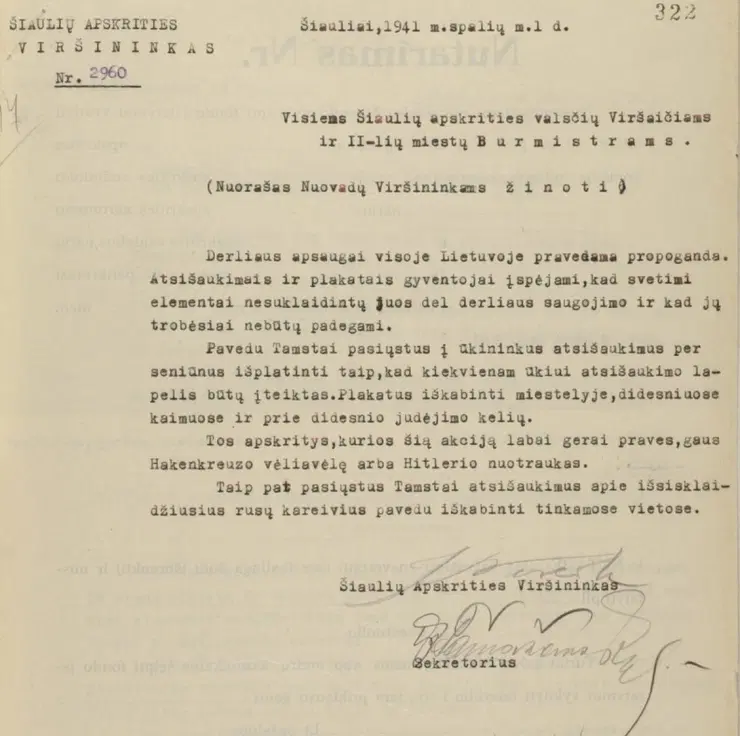
Nazi Germany’s will manifested itself expressly through Jonas Noreika. He was Hitler’s doll.
Jonas Noreika dragged all of Lithuanian society into his crimes: officers, policemen, officials, clergymen, teachers, businessmen, intellectuals and the youth.
Jonas Noreika is unequivocally reprehensible.
It is necessary for morality to unequivocally judge negatively criminals against humanity such as Stalin, Noreika and Hitler, who maliciously condemned their victims and never renounced their evil deeds. In judging them equivocally, we injure their victims and all of humanity.
It is immoral to consider the virtues of such criminals, for example, Hitler’s vegetarianism, his artistic talents or love for Eva Braun. I agree that Noreika cared for Stuthoff prisoner J.Jurgutis and saved his life. It is ironic that Jurgutis was of Jewish origin. This shows that Noreika, just like every person, could do good. But that all fades away in the face of the merciless evil against humanity which he conceived, implemented and then justified. What Jonas Noreika may not be forgiven is that he never regretted how he wounded humanity’s unity, and along with that, Lithuania’s unity. He didn’t even consider his victims to be human beings. If there are those who admired him or even admire him, then it must be comprehended that in his crimes against humanity he exploited people’s confidence in him and their faith in Lithuania and Lithuanianness.
Do you agree that Jonas Noreika horrified Matas Krygeris?
In remembering the extraordinary LAF activists who participated in this meeting I wonder why they, who had suffered Stalin’s beastly tyranny and the devastation of the Lithuanian nation, soiled their hands with Lithuanian blood. Is that not a perversely understood patriotism?
You may ask, But why did Matas Krygeris not name the extraordinary LAF activist Jonas Noreika? Matas Krygeris, defender of the abused, who experienced a Nazi prison and Soviet threats, left an explanation in his memoirs. “I would not dare to mention such facts about a person, if they had not already been published by others in the press.” (“Rūstūs prisiminimai”, 1994, p.68).
I, Grant Gochin, dare to name Jonas Noreika as a horrendous criminal, responsible for the genocide of innocent people. Aleksandras Pakalniškis named him. Stanislova Pocienė named him. Jakovas Bunka named him. My researchers, Andrius Kulikauskas and Evaldas Balčiūnas, name him. Jonas Noreika’s granddaughter Silvia Foti names him.
Your Research Department Director Arūnas Bubnys wrote, after the restoration of independence, “Matas Krygeris, honorary member of Lithuania’s Lawyers Association, concurs with T.Venclova’s opinion that the 1941 rebellion and the blood shed was useful not so much for Lithuania as for Nazi Germany. Not doubting the rebels’ holy purposes, M.Krygeris thinks that now it is the duty of independent Lithuania to bring to light and condemn those who committed excesses.” (Martinionis, 1941 m. birželio 22-28 d., p.225)
According to A.Bubnys and M.Krygeris, it is the duty of independent Lithuania to bring to light and condemn Jonas Noreika.
People must not condemn people, but only their behavior. The state, however, may and must condemn the enemies of humanity. There are people who have committed crimes so maliciously, mercilessly and devotedly, such as Stalin, Hitler and Noreika, that the state must not limit itself to naming their crimes, and must not look for or acknowledge any virtues they may have. The state, in empathizing with their victims, must understand these people unequivocally as enemies of humanity.
I demand that the Republic of Lithuania’s budgetary institution, the Genocide and Resistance Research Centre of Lithuania, evaluate the facts and documents established in the course of this investigation and change the Centre’s current conclusions regarding Jonas Noreika’s activity, discussing all of the historical circumstances and documents laid out above.
I ask that you publish your new conclusion about Jonas Noreika’s activity at your website. Write about the changed conclusion to all of the individuals and institutions to whom the earlier conclusions were sent.
Respectfully,
Grant Arthur Gochin
June 15, 2018

